Customer Journey vs Customer Experience Maps: Which One Should You Use?
If you’re a marketer, you’ve probably already heard the terms customer journey, customer experience maps, customer funnel, and plenty of other very similar-sounding jargon. And if you’re like most people, you’ve probably been wondering “what do you mean customer journey vs customer experience maps? Aren’t they the same thing!?”
Well, they’re not, but both these terms are still used interchangeably due to common misconceptions.
As a result, people often end up using the wrong tool for the wrong task. Fortunately for you, we’re doing a deep-drive into both customer journeys and customer experience maps to help you understand exactly which one you should be using for specific purposes.
So, let’s get started.

What is Customer Journey Mapping?
A customer journey is the entire path a customer takes in order to make a purchase. This path can be across multiple touchpoints, involve several modes and channels of communication, and can span durations ranging from a few minutes (hello online shopping!) to a few months.
So, as the name suggests, customer journey mapping refers to visualizing every step taken from the start of the customer’s interaction with the business, until after the sale has been made.
Let’s illustrate this with the help of an example. A customer could see a social media ad for your products, click on it for more information, and decide to buy the product. Later they could call customer services to get assistance on how to install the product.
Every interaction in this example would be a part of that customer’s journey map.
The biggest difference between a journey map and an experience map is that Customer Journey Maps are about only a single product or service offered by your business. Yes, it includes every single interaction a customer makes with your business, but only related to a particular product.

When to use Customer Journey Mapping
Marketers and sales professionals often need to check out the customer journey to optimize the customer retention funnel . For instance, if you identify that customers interact with you the most on LinkedIn for everything from demos to complaints of a particular product, you can start focusing more on this channel compared to others.
Remember though: the key here is that you must only map out the customer journey for one specific product at a time because even different products from the same company can have completely different audiences and customer journeys.
But then what are customer experience maps?
What is a Customer Experience Map?
Customer Experience Mapping is a lot more comprehensive than customer journey mapping. The major difference between a customer experience map and a customer journey map is that the customer experience map isn’t limited to a single sale or even one product. A customer experience map covers all touchpoints whether or not they resulted in a sale whereas a customer journey pertains only to a single sale and the steps that were involved in it.
Customer experience analysis also has a lot to do with the emotions and behaviors of users. In essence, customer experience mapping can help you dive into what drives your users’ actions, allowing you to make relevant changes to give your users a good overall experience when they’re interacting with your business.
What’s interesting is that a customer experience map could include a journey map, but also takes into consideration other interactions the customer might have had with your business other than the journey for that specific product or service.

When to use Customer Experience Mapping
Customer experience maps are used when you know that you have a problem with your marketing strategy but aren’t able to pinpoint where the problem lies. Since a customer experience map takes all touchpoints into consideration, you’ll be able to identify exactly where your customers are dropping off, allowing you to make specific changes and perform A/B tests to see how your users respond to them.
Let’s look at this further with an example.
Say that you have a good amount of traffic to your website and to your landing pages, but at some point most of those prospects fail to convert.
You know you have something in your website that is repelling many leads, but you don’t know what it is or where it is.
A Customer Experience Map can show you the certain points where those leads decide against converting and leave your website.
This way you will pinpoint the source of the problem and work to solve it.
Settling the Customer Journey vs Customer Experience Map Debate
Looking at these two methods from a ‘customer journey vs customer experience map’ lens isn’t fair as both of these mapping methods are used to track customer interactions with your brand. That said, while Customer Journey Maps are only tracking the touchpoint related to the sale of a single product or service, Customer Experience Maps track every single touchpoint and how the customer responds at each stage.
Both of these methods can help you find solutions to issues you have in your marketing process and sales funnel . A journey map will be more useful if you know where the problem is since it is more focused already. In contrast, an experience map will be more beneficial if you need to spot the problem first thanks to its more comprehensive nature.
These customer maps will help you step into your customers’ shoes and have a better understanding of them. Remember though, customer journey mapping and experience mapping is an ongoing process. This means that you can’t just map the customer experience or customer journey map once. You will have to update the maps you create every now and then to ensure that they are still relevant and your insights aren’t outdated.
Customer journey maps only deal with the path taken by the customer to make a single purchase. Experience maps, however, record any and every action of the customer. Journey maps are more specific and will be more helpful if you know exactly what you are looking for whereas experience maps will be more helpful if you are doing general research on improving your funnels.
Journey maps let you know how each customer came to buy a particular product. This information will be useful when you are trying to see which channels drive more qualified leads for different products —and eventually help you improve your marketing efforts.
Experience maps show where each customer spends their time on your website. This can project which pages have high rates of conversion, what people tend to do after visiting certain pages, how long it takes for customers to make a purchase, etc. According to this information you can further improve your landing pages and optimize your website to give better results.
Latest Posts

Marketing Influence on Outbound Deals

B2B SaaS Linkedin Ads Benchmarks

The State of Pricing, Demo, and Case Study Pages

Uncover What Drives Revenue
- Ultimate Ipsum
The 1 Simple difference between customer journey maps and experience maps
- by Taylor Wegner
- February 2, 2021 November 10, 2021
Customer Journey Mapping and Experience Mapping probably sound awfully similar to the uninitiated. If you’ve found yourself in this position, you may ask what every person who’s begun their journey into UX has asked: “What’s the difference between a journey map and an experience map anyway?”
The Short Answer
Customer journey maps are specific to a persona.
A journey map is also known as a customer journey map. These map the timeline of a specific type of customer (or persona) experiencing a product. The customer experience is segmented into stages across the horizontal axis, and lists customer ‘states’ down the vertical axis. Common states you’ll find are Thinking, Feeling, and Doing.
To effectively represent these specific types of customers/users, UX Designers often use Personas. Personas are stand-ins, based in research, for target segments of customer populations.
Experience Maps are Generalized
An Experience Map is similar, but more generalized. It still maps the experience of a product in stages across one axis and states across the other. But it does not represent a specific customer type or persona. It’s a generalized diagram of the experience that most average customers will have. As with Customer Journey Mapping, it’s also common to find Thinking, Feeling, and Doing states.
However, in both mapping artifacts, you’ll often see two more categories at the bottom of the ‘states’ axis. “Pain Points” summarizes the least-desirable user experiences during each particular stage and “Opportunities” contains actionable improvements that can be made by the product.
Here’s Why Mapping Experiences is Important
This is the big sell: at any stage of the development process, Product Owners and Managers can use a map artifact like these to not only get cross-channel teams on the same page, they can use the Opportunities category to build out their backlog and roadmap.
I’m talking user-centered strategy, organization, communication and planning all rolled into one handy visual tool.
As part of a successful design thinking methodology , these mapping techniques should be at the top of your tool box.
The difference between a customer journey map and an experience map is context.
Experience Mapping is generalized, while Journey Mapping is specific to a customer, user or persona.
And these techniques are not mutually exclusive. As part of a successful design thinking methodology , both of these mapping methods should be will be indispensable tools in your belt.
Both should be used at-will. The difference between customer journey map and experience map methods may seem like semantics, but each has its specific uses. So it’s only a matter of when, and which, each method will best serve your needs at a given time.
References and Further Reading
- Gibbons, Sarah. “ UX Mapping Methods Compared: A Cheat Sheet .” Nielsen Norman Group. 2017.
- “ Customer Journey Mapping .” Team Playbook . Atlassian. Accessed 2 Feb 2021.
- “ Customer Journey Maps .” Interaction Design Foundation. Accessed 2 Feb 2021.
Leave a Reply Cancel reply
Your email address will not be published. Required fields are marked *
Save my name, email, and website in this browser for the next time I comment.

Journey Mapping Vs. Experience Mapping: Which one is for you?
- January 5, 2023
A customer journey map is a visualization of your customers’ steps to interact with your company, from awareness to purchase and beyond. A customer experience map does the same thing, including emotions and other factors influencing the customer’s decision-making process.
If you’re not sure which type of map is right for you, consider your goals and objectives. If you want to focus on improving the overall customer experience, a customer experience map may be a better choice. A customer journey map may be a better fit if you’re mainly interested in understanding the customer’s purchase journey. This article will give you what you need about mas to choose your path wisely.
Table of Contents
What is Customer Journey Mapping?
Customer Journey Mapping (CJM) is a tool businesses use to track and improve the customer experience. It involves creating a map of all customer touchpoints with a company, from their first brand awareness to post-purchase follow-up. This helps businesses identify areas where the customer experience can be improved and change how they operate accordingly. CJM can be used in a variety of industries but is especially useful for companies that deal directly with customers regularly, such as retailers or service providers.
When can you use Customer Journey Mapping?
There are a number of situations where Customer Journey Mapping can be helpful. If you’re looking to improve your customer experience, identify areas of friction, or better understand how customers interact with your business, CJM can be a valuable tool.
What is a Customer Experience Map?
A Customer Experience Map is a tool that businesses use to track and improve the customer experience. A customer experience map covers all touchpoints, whether or not they resulted in a sale, whereas a customer journey pertains only to a single sale and the steps involved in it.
Customer experience map can also be influenced by the emotional and behavioral responses of customers and users. In essence, customer experience mapping can help you dive into what drives your users’ actions, allowing you to make relevant changes to give your users a good overall experience when interacting with your business.
When can you use the Customer Experience map?
A customer experience map, in contrast to journey mapping is more effective if you don’t know where the problem is. You know something, somewhere, is falling short, and by approaching the exercise in an honest and open-minded manner, you can hopefully nail down exactly where the customer pain point’s are when before, you might not have known they existed at all. One common pitfall to avoid is mapping out what you think the user experience should be when you want to map out what the experience is in the customer’s eyes, warts and all.
Also Read : Who Earns More, Web Developer Or UI UX Designer?
Four Types of Mapping for Customers
Empathy map, customer journey map, service blueprint, experience map.
An empathy map is a tool that helps businesses understand their customers on a deeper level. It involves creating a map of all the touchpoint’s a customer has with a brand, from their first awareness of the product or service to post-purchase follow-up. This helps businesses identify areas where the user experience can be improved and change how they operate accordingly.
The customer journey map is similar to the empathy map but focuses specifically on the customer’s journey with your business. This includes all of the steps they take, both online and offline, as well as any interactions they have with your company along the way. By understanding the customer journey, you can improve the overall experience and make sure that every touchpoint is positive.
You May Like : What to make a UI UX resume look like?
A service blueprint is a tool that helps businesses understand how their product or service is delivered to customers. Service blueprints are counterparts to customer journey maps focused on the employees. It involves mapping out all of the steps involved in the delivery process, from start to finish. This helps businesses identify areas where there is room for improvement and change how they operate accordingly. Also, you can use it after customer journey mapping, Before making organizational or process changes, and when pinpointing a funnel or breakpoint internally.
An experience map is a tool that helps businesses understand the customer’s overall experience with their brand. It involves mapping out all the touchpoints a customer has with a company, from their first brand awareness to post-purchase follow-up. This helps businesses identify areas where the customer experience can be improved and change how they operate accordingly.
Conclusion.
Customer Journey Mapping is a valuable tool for businesses that want to improve their customer experience. By understanding the journey customers take with your business, you can ensure that every interaction is positive and that your brand consistently delivers on its promises. Several different types of mapping tools are available, each of which has its benefits. Choose the best suits your needs and start improving your customer experience today.

Ui UX design services
Our Ui UX design services help you improve your user’s experience and let them enjoy checking out your website or application. We help make your interfaces more user-friendly and efficient. UI/UX design services can also help you gather valuable feedback from customers to improve your product or service.

- Graphic Design , UI-UX
How to Become a Motion Graphic Designer?

A Brief Overview of Lean UX

UX Strategy and Its Components
you'r more than welcome
7 days a week, 9:30 AM – 5:30 PM
contact info
[email protected] +351910923549
- LB07129, Jebel Ali Freezone, Dubai, UAE
Got a Project?
We’re a team of creatives who are excited about unique ideas and help companies to create amazing identity by offering wide range of digital services
© 2021 All rights reserved.
Be the first one who knows about updates!
enter your email address 📩
Welcome to the club 🎉.
From now on, Temis will inform you of its most valuable content and offers. You can also subscribe to this list at the moment. We will also protect your privacy
Customer Experience Map or Journey Map?

At Heart of the Customer, we’re known for creating world-class journey maps. (You could even say I’m driven by it, as you can see from my license plate!)
But sometimes, it’s not a journey that you need to map.
When a potential client contacts us to inquire about customer journey mapping, we first ask, “What are you looking to learn?” If the answer is “the customer journey,” we will be asking many more questions.
Understanding the Terminology
“What is the right journey?” is the second question in our Five-Question Framework . At the extremes, you would map either the end-to-end customer experience mapping or a specific sub-journey. Some CX folks refer to these as a customer experience map or a journey map, so I’ll use those terms for this post.
At the risk of oversimplifying, you need a customer experience map when you don’t know exactly where the problem is, and a journey map when you do, but need to go deeper.
In early 2019, CustomerThink CEO Bob Thompson put together an excellent piece of research that still talk about years later. (I originally wrote about it here .)
It honed in on what separates successful CX programs from the rest. The critical differentiator was that the best programs started with a customer experience map to understand the overall experience and biggest opportunities. They then created multiple journey maps to explore those findings in more depth.
So, what is a customer journey map?
A customer journey map is a detailed visualization of a customer’s interactions with a brand, product, or service. It charts the customer’s path from the first point of contact to the ultimate purchase, including any after-sales interactions.
It allows us to see our company’s processes from the customer’s perspective, helping us identify areas for improvement to enhance overall customer satisfaction.
What is a customer experience map?
A customer experience map goes a step further and goes beyond interactions with our business. It considers the customer’s broader experiences and emotions throughout their journey, accounting for feelings, motivations, and expectations at each step.
Customer Experience Maps go Wide
What is the purpose of a customer experience map.
The purpose of a customer experience map is multifold:
- Understanding customer perspective
- Identifying pain points and opportunities
- Unifying vision and strategy
- Designing better products/services
- Improving retention and loyalty
1. Understand Customer Perspective
An experience map helps us understand the customer’s perspective. It also helps us empathize with their needs and feelings by focusing on their emotions throughout their journey.
It goes beyond the ‘what’ and delves into the ‘why’ and ‘how’ of customer behavior.
2. Identify Pain Points and Opportunities
This tool identifies customer dissatisfaction areas and highlights opportunities to delight customers. It helps enhance our vision and strategy.
3. Unify Vision and Strategy
A customer experience map provides a holistic view of the customer journey. This can guide cross-departmental strategies.
It allows teams across the organization to understand their impact on the customer experience and align their goals.
4. Design Better Products or Services
By better understanding our customers’ emotions, expectations, and reasons for interacting with us, we can improve our products or services to meet their needs better. This results in higher customer satisfaction and loyalty.
5. Improve Retention and Loyalty
A positive customer experience often leads to repeat purchases and customer loyalty.
By mapping and improving the customer experience, we can increase customer retention and build long-lasting relationships that increase the lifetime value of a customer.
When to use experience maps
Experience maps work well when you need a broad understanding. Some use cases include:
- Inform new leadership (including a new CX leader) on the current state of the customer experience.
- Build a listening post strategy across the entire experience.
- Understand a specific customer segment, such as a generation or a new market.
- Diagnose challenges with customers of an acquired business.
About a third of our projects focus on an experience map. (Check out our book, How Hard Is It to Be Your Customer? , to see how “ABC Software” created an experience map to build their listening strategy for a segment of banks.)
In the “AquaLabs” sample map to the right (with anonymized text), a medical device company gained an understanding of a specific segment of healthcare practitioners (HCPs) who were only buying from them sporadically.
The company needed to learn how these HCPs worked with patients so that they could build programs appropriately.
Now look at the Meridian map pictured below. Notice how far more real estate is dedicated to what customers do than on the Meridian map?
Emotions are displayed in both, but they’re a relatively small part of the top map, unlike on Meridian’s, where they play a larger role. That difference goes back to AquaLabs’ goal: to understand what the HCPs do.
Customer Journey Maps go Deep
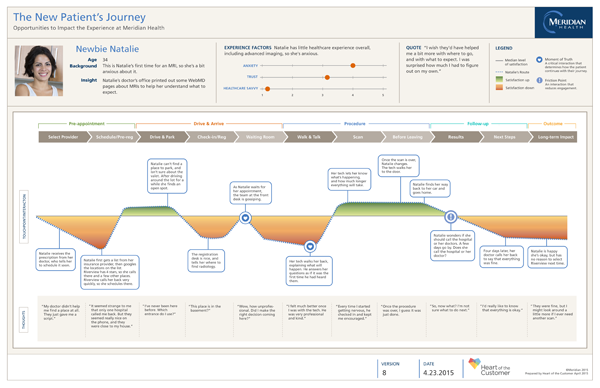
What is the purpose of a customer journey map?
Here are the key purposes of a customer journey map:
- Understanding customer interactions
- Identifying customer pain points
- Enhancing customer experience
- Unifying cross-functional teams
- Improving business performance
- Future planning and strategy
1. Understanding customer interactions
A customer journey map visually represents every interaction or touchpoint a customer has with a brand, product, or service.
This helps us understand the customer’s path and how they interact with our business.
2. Identifying customer pain points
By mapping the customer’s journey, we can identify points of friction or dissatisfaction in their interaction with our business.
These ‘pain points’ help us understand where we need to focus our improvements.
3. Enhancing customer experience
With a clear picture of our customers’ journey, we can better align our business processes and services to their needs.
This alignment leads to an improved overall customer experience.
4. Unifying cross-functional teams
Since the customer journey often spans different organizational departments, a customer journey map helps ensure all teams understand the customer’s path and role.
This unity promotes a customer-centric culture throughout the organization.
5. Improving business performance
By improving the customer’s journey, we enhance their satisfaction and loyalty, which in turn drives business growth.
The journey map provides actionable insights to increase conversion rates and foster customer loyalty.
6. Future planning and strategy
A customer journey map can also be used to plan for the future. It can be a valuable tool in:
- Predicting potential roadblocks
- Planning for product/service updates
- Strategizing marketing and sales initiatives
When to use customer journey maps
Journey maps work best to diagnose a specific portion of the overall experience. Some common examples:
- Customer attrition after a specific interaction.
- Poor survey scores for a portion of the journey.
- New business initiatives need to be informed by the voice of the customer (such as a new website or communications program).
For example, the map below is based on work Heart of the Customer did with a life insurance company. They had the initiative to change their underwriting and wanted to understand how their customers – in this case, financial professionals – felt about the existing journey.
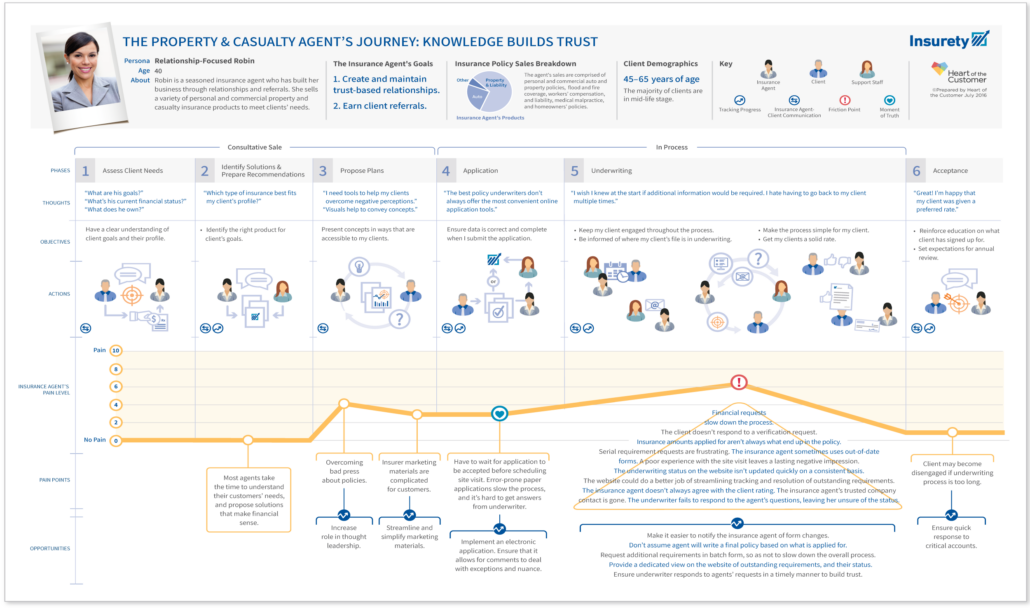
Notice again that a fair amount of space was used to show what customers did. This isn’t true of most of our maps but again happens to be the case here.
Also, as there is little joy in underwriting, it only shows friction levels, as opposed to the Meridian map above, which reflects positive and negative emotions.
The Meridian map, featured in Jim Kalbach’s Mapping Experiences book and ours , is from a journey mapping initiative conducted for Meridian Health.
For that project, Meridian wanted to focus exclusively on the advanced radiology journey, from test scheduling to receiving results back from the doctor.
The steps of the journey were well-known, but Meridian needed to find out how customers felt about them.
Selecting the right scope for your mapping initiative is one of the top three requirements to drive change through journey mapping effectively.
There isn’t one choice that will be right for every situation. It comes down to fully understanding the current state of your experience…and the changes you need to drive to improve it.
Related Reading: The ADKAR Change Model and Customer Journey Maps
Customer Experience Map vs. Customer Journey Map Differences
The concept of a customer journey refers to a strategic approach encompassing all customer behaviors and engagements with a specific brand.
Customer Experience, often called CX, signifies how a business establishes and maintains connections with its customers throughout their journey – from the initial contemplation stage to becoming an advocate for the brand.
You can find out more in the following table.
How are Customer Personas Used in Customer Experience and Journey Maps?
Customer personas are integral to the development of customer experience and journey maps. They provide detailed insight into your target audience, helping to shape and define the stages, touchpoints, and experiences along the customer journey. Here’s how they’re used:
- Understanding customer behavior
- Identifying touchpoints
- Highlighting pain points
- Personalizing experiences
- Predicting customer needs
- Guiding product development
1. Understanding customer behavior
Personas embody different customer segments’ needs, motivations, and behaviors. By incorporating them into experience and journey maps, businesses can better understand how different types of customers interact with their brand, product, or service.
2. Identifying touchpoints
Customer personas can help identify where customers interact with your business, whether through your website, a physical store, or social media platforms. By understanding these touchpoints, you can map out a more accurate and detailed customer journey.
3. Highlighting pain points
By understanding your personas’ goals, expectations, and potential barriers, you can use journey maps to identify and visualize their pain points. This can drive strategies for improving the overall customer experience.
4. Personalizing experiences
Understanding the preferences and needs of different personas allows businesses to tailor experiences and communications to resonate with them. This level of personalization can be outlined in your customer journey map.
5. Predicting customer needs
Journey maps, when created with customer personas, can help predict future customer needs. By understanding what drives your personas, you can forecast how their journey might evolve and proactively meet those needs.
6. Guiding product development
Personas can inform the direction of product development by providing insights into what features or services are most valuable to different customer segments. This can be integrated into experience maps to guide strategic planning.
Common Mistakes to Avoid when Creating Experience Maps and Journey Maps
Creating an Experience Map or Journey Map is not always a walk in the park. Throughout my career, I’ve seen numerous common pitfalls that can derail these essential tools for understanding and improving the customer journey.
Let me share some of the most frequent mistakes to avoid:
Lack of clear goals
Ignoring the customer’s perspective, relying solely on assumptions.
- Creating overly complex maps
Not updating maps regularly
- Not involving cross-functional teams
Neglecting to use the map
It’s easy to jump headfirst into creating an Experience Map without defining what you hope to achieve. Remember, these maps are tools designed to uncover specific insights about the customer journey. Ensure your goals are clear, achievable, and relevant to the task.
Here are some examples of goals related to experience and journey mapping:
In my early days, I made the mistake of creating journey maps based solely on my internal business perspective. It was only when I took the time to incorporate customer experiences, emotions and needs into the map that I truly began to see its value. Always build your map with a customer-centric view.
It’s tempting to use internal assumptions to fill gaps in your map. However, relying solely on assumptions can lead to a skewed view of the customer journey. Always base your map on real data and insights from customer feedback where possible.
Overly complex maps
While creating detailed maps may seem beneficial, it’s easy to get lost in the weeds. Overly complex maps may discourage stakeholders from fully engaging with the insights. Strike a balance between detail and simplicity, ensuring the map communicates its key messages clearly.
The customer journey isn’t static; it constantly evolves as customer behaviors and expectations change. I’ve seen businesses create excellent maps, only for them to become obsolete because they weren’t updated regularly. Treat your maps as living documents, updating them as new data emerges.
Not involving cross-functional teams
Creating an Experience Map or Journey Map should not be done in isolation. I learned this the hard way when I created my first journey map without the input of key stakeholders. Now, I involve representatives from all relevant departments, as their insights can be invaluable in creating a more accurate map.
After investing time and resources into creating a comprehensive Experience Map or Journey Map, it can be easy to neglect the final step: using it to drive decision-making. Ensure you communicate the map’s insights to stakeholders and use it to inform your strategic decisions.
Final Thoughts
At Heart of the Customer, we are committed to accompanying you throughout this journey. Our dedication extends to assisting you in identifying and meeting your requirements, overcoming challenges, optimizing time management, streamlining processes, and, ultimately, enhancing both customer and employee experiences .
In today’s rapidly changing business environment, a robust employee experience strategy is not a luxury but a prerequisite for success. Not letting your strategy fall behind is crucial to ensure you stay ahead. Feel free to contact us at Heart of the Customer, and together, we can chart a distinctive employee journey that will propel your employee experience to unparalleled heights.
Get in touch today!
→ Contact Us Now
Is an experience map the same as a journey map?
An experience map is typically broader and more holistic, detailing the customer’s experiences across various touchpoints and interactions over time. It often includes multiple channels, processes, and customer personas.
A journey map, on the other hand, focuses on a specific customer’s path from their perspective, detailing their thoughts, feelings, and experiences as they interact with a product or service.
Can both customer journey maps and customer experience maps be used simultaneously?
Absolutely. While these maps serve different purposes, they complement each other well. Using both simultaneously can provide a more comprehensive view of your customer’s interactions and experiences with your brand. The journey map can provide specific insights into the customer’s path, while the experience map can give a broader view of the customer’s overall interaction with the brand across multiple touchpoints.
What tools can I use to create customer journey and experience maps?
Several tools are available for creating these maps, ranging from basic to more complex. Simple tools like Microsoft PowerPoint, Google Slides, or even physical whiteboards can be used to create basic maps. You might consider using specialized software like UXPressia, Smaply, or Microsoft Visio for more detailed and interactive maps. Many of these tools offer customizable templates, making it easier to create effective maps.
For more tools, read on in our CX Technology blog category.
Keep reading .

A Positive Emotional Experience = Good for Customers, Profitable for You
By Jim Tincher

Navigating Customer Experience Maturity: The Road to Success

To be a change maker in CX, focus on business outcomes
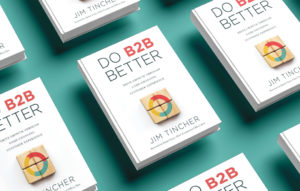
Books About Customer Experience: 9 Best Reads for CX Professionals
By Shawn Phillips
Stay updated with our insights .


- Demo Videos
- Interactive Product Tours
- Request Demo
What is User Experience Mapping?
User Experience Mapping, also known as Customer Journey Mapping (CJM) is a powerful technique for understanding what motivates your customers - what their needs are, their hesitations, and concerns. Although most organizations are reasonably good at gathering data about their customers, data alone fails to communicate the frustrations and experiences the customer experienced. A story can do that, and one of the best storytelling tools in business is the user experience map.
User Experience Mapping is a powerful technique for understanding what motivates your customers - what their needs are, their hesitations, and concerns. Although most organizations are reasonably good at gathering data about their customers, data alone fails to communicate the frustrations and experiences the customer experienced. A story can do that, and one of the best storytelling tools in business is the user experience map.
User Experience Mapping uses storytelling and visuals to illustrate the relationship a customer has with a business over a period of time. The story is being told from the perspective of customer, which provides insight into the total experience of the customer. It helps your team better understand and address customer needs and pain points as they experience your product or service. In other words, mapping out the customer journey offers your business the chance to see how your brand first engages a potential customer, and then moves through the touchpoints of the entire sales process.
Why User Experience Mapping?
The purpose of User Experience Mapping is to understand what customers go through and improve the quality of your customer experience, ensuring consistency and a seamless experience at all touchpoints and across all channels. There is no substitution for listening to your customers about how the steps in the journey are working out for them. Having built an understanding of the customer journeys with your business you are now in a position to improve the customer experience enables:
- Provides a bird's eye view of the entire customer journey
- Bring teams together to resolve specific customer hurdles for understanding core customer journey paths, where additional development will provide biggest impact.
- Build faster and higher customer conversion rates by minimizing negative customer experiences, through identification of key steps and decision points.
- Improved customer retention, through understanding how they transit through, say, each stage of a procurement cycle to ensure the correct information is available and accessible to all stakeholders.
- Allows a business to zoom-in a single customer journey in a specific channel.
- Understanding of required metrics to identify customer's progress and fall out points, providing opportunities to bring customers back on board.
- Allows businesses to prioritize actions in their customer experience strategy
- Reveals the gaps between various channels and departments

Basic Concepts of CJM
Customer journey is a journey of a potential customer about different points of contact with a product, a brand or (touchpoints) of a company via all available channels until he performs a desired target action. A customer journey can extend over several hours or days.
- Major target actions are purchases, orders or inquiries.
- Touchpoints are any kind of contact points between customer and your business, from classical advertising (ads, TV or radio spot, etc.) through online marketing activities through to the opinion of a friend or information on review sites.
- Available channels such as telephone, web, branch, marketing communications and service interactions.
Creating User Experience Map
User Experience Maps can take a wide variety of forms. The end goal, however, is always the same: find and resolve the pain points of your customers.
Step 1. Define your persona
Personas and journey maps are both important strategic tools that help provide an in-depth understanding of who your customers are, what they need, and how they interact with your business across all touch points. But more importantly, for sharing customer insights across the organization. Much of the information for creating a User Experience Map comes from your personas (e.g., their goals, motivations, key tasks they want to accomplish, and current pain points), which is why it's best to create the personas first.
The first thing you need to decide is whose journey you are going to map such as, a specific customer type (persona), a potential (target) customer, or a segment of customers, depending on the purpose of your journey mapping initiative. Once you've created distinct personas, you can use them to create user experience maps that describe each persona's experience at various touch points during their lifecycle with your company.

Step 2. Define your customer phases
User Experience Maps are typically organized by customer stages (sometimes referred to as phases). Each stage represents a major goal your customer is trying to achieve in their overall journey. You should build a user experience mapping with stages that represent your customer's goal-oriented journey, not your internal process steps.
So once you've defined your persona, you have to identify the stages of the customer's journey. What process does it take to start from consideration all the way through buying your product or services? Based on the persona define the stages that your customer experiences with you over time. Define how, when and where they: discover your company, research your products or services, choose you over competitors, purchase from you, and maintain a relationship with you.

Step 3. Describe the Touchpoints Your Customer Uses to Interact with Your Organization
Customer touchpoints are your brand's points of customer contact, from start to finish. For example, customers may find your business online or in an ad, see ratings and reviews, visit your website, shop at your retail store or contact your customer service. This seems like a long list, but these are just a few of your touchpoints! Identifying your touchpoints is an important step towards creating a user experience M=map and making sure your customers are satisfied every step of the way.

Step 4. Conduct research
While you may need to offer some incentives for participation, most people are happy to help if they believe you are genuinely interested in their experience and will use their feedback to improve things for others.
For each stage of the journey, try to identify:
- What were their goals, what did they want to achieve
- What did they expect the process would be like
- The steps and touchpoints they used to complete the stage
- How did they feel emotionally during each touchpoint experience and why
- Other thoughts they had during the stage
- How long did it take to complete
Step 5. Determine points of friction
Once you have understood your persona's goals and written down their touchpoints, it's time to look at the big picture - the totality of their experience with your company. Every business will look through the lens of their customer personas differently. Walking through each of the User Experience Map stages with your team will help you identify any points of friction within the customer experience.
Of course, every business is different and YOU will know your customers best. There are a few example questions below to get you started:
- Where could friction appear in this particular touchpoint?
- Are people abandoning purchases because of this?
- Are customers not aware of this solution that you've already provided? If so, why not?
Step 6. Resolve
User Experience Maps aren't meant to be purely illustrative. A typical exercise should identify a few quick fixes, including opportunities to boost enjoyment and improve the journey. And, of course, most firms discover the process helps drive broader customer experience improvements as customer needs are better understood and met. In brief, mapping the journey should help lead to specific actions that improve the experience and drive the ROI. Treat your map as a living document to be revisited regularly and updated as required and remember to share it with any relevant stakeholders
Other Techniques for applying a CJM
Improvement and innovation using user experience map.
Identifying opportunities to drive growth through investing in customer experience improvements is a key objective of many user experience mapping initiatives. You should build a user experience map as a tool to use in your action planning. This will show where you identify opportunities, assess their impact, cost, etc. and eventually set investment priorities for your organization.
Some maps explicitly list out the key opportunities on the map itself. This can be helpful as a communication tool, especially if the key opportunities are added after opportunities have been prioritized. In this way, the User Experience Map becomes an ongoing communication and governance document.
Visualize Frontstage and Backstage In User Experience Map
Up until now, I've focused on the frontstage or outside-in view of the journey. The backstage refers to the internal systems, processes, and people that are involved in delivering that journey. This is the inside-out view of the journey. When combined in a single User Experience Map, these two views are often referred to as a Frontstage/Backstage Map or an Eco-System Map.
Mapping the frontstage and backstage on one map creates visibility to the internal resources and processes that are responsible for delivering the customer experience-visibility that can help your organization understand what is involved in delivering and ultimately improving the customer experience.

A checklist for Developing User Experience Map
Here are the questions you will ask yourself while creating a user experience map:
- How are your customers finding you and how do they solve (or cope with) the problem before using your solution?
- What is the customer problem you are trying to solve? Or in other words, what are the common problems and pain points customers experience that your product can help alleviate?
- How easy is it for customers to gain access to customer service for support?
- How are you trying to improve customer engagement across channels?
- Is it easy for the customer to pay for your product or service?
Related Links
- Professional User Experience Mapping tool
- YouTube video - What is User Experience Mapping?
- Try Visual Paradigm FREE
Turn every software project into a successful one.
We use cookies to offer you a better experience. By visiting our website, you agree to the use of cookies as described in our Cookie Policy .
© 2024 by Visual Paradigm. All rights reserved.
- Privacy statement
Everything you need to know before customer journey mapping

Both customer experience (CX) and user experience (UX) professionals should require the use of user or customer journey mapping in determining the ideal customer and user experience, says Forrester Analyst Leah Buley in this EffectiveUI blog post .
The rising importance of CX and UX has inspired us to share our collection of the most comprehensive instructions from our corporate Miro library, which we hope will be helpful in your customer journey mapping too.
Look through this brief presentation about customer journey mapping or read the full article below.
Why did we collect this information? Because current trends prove that ideal customer experience is going to be a cornerstone of a company’s success soon.
According to Econsultancy Digital Trends 2015 report , which was based on a global survey, customer experience is considered to be the main opportunity in 2015-2020 to differentiate from competitors, beating out current markers of success (like product quality and competitive pricing).
Read our recent post on the four remote collaboration trends that drive the adoption of virtual whiteboards for customer journey mapping.
It means that customer experience soon will be, if it is not already, the key factor determining referral, retention, revenue and overall growth in the majority of businesses.
[rtb_inline_subscription id=”1″ size=”small” header=”Subscribe to get more insightful guides for UX professionals” button=”black”]

Another study conducted by Esteban Kolsky (a customer strategist, researcher, and consultant) shows, among other things, that customers are looking for a guaranteed quality experience.
Kolsky’s results show that only 1 out of 26 unhappy customers regularly complains and that the rest simply churn; he also finds that 67% of consumers cite bad experiences as the reason for churn. Ultimately, at least 91% of unhappy customers will simply leave without a complaint.
Currently, most companies are struggling to get customers’ attention and acquire new-comers, but this is not a financially sound strategy: “it is 6-7X more expensive to attract new customers than to keep existing customers,” according to the research.
That means that the real competition starts in the middle of the marketing funnel and that the focus really needs to be on improving the experience for existing customers. The question then becomes: How best to implement strategies that will be successful in this area?
What is customer journey mapping?
The customer journey map (CJM) is one of the main tools that allows us to understand and improve customer experience. This video from Peer Insight shows a sample Customer Journey Map in action; but in essence, it is a graph which illustrates the steps customers go through: from initial contact, through the process of engagement, and hopefully into long-term loyalty. It may focus on a particular part of the story or give an overview of the entire customer experience as they interact with a company — whether it is a product, a website, a retail store, a service, or any combination of these. It usually treats individuals as real or potential customers, so it shows a path how people either become customers or leave.
The more interaction steps are described, the more complicated — but also the more informative and useful — such a map becomes.
There is an endless number of customer journey map templates, but a basic template includes a specific persona, the steps beginning-to-end of the customer experience (including touchpoints), and the potential emotional highs and lows. Other parts of the journey are optional and depend on your objective.
As Paul Boag, a user experience consultant, speaker & author of Digital Adaptation, says, participation in creating customer journey map is useful for all involved in product development :
However, the finished map could be simplified and expanded to the entire company under the condition of non-disclosure.
The process of customer journey mapping
The process of customer journey mapping varies from one company to another. Usually, it depends on the resources you have (people, time, equipment, etc.), the template, and the facilitator’s experience. Below you can find one of thousands of possible scenarios for customer journey mapping.
Step 1: Gathering information
During this phase, you have to define a customer persona that is relevant to your goal and the scope of activities you would like to assess, and then gather the maximum data about this persona. How does one gather this data? You will want both quantitative and qualitative information to gain the deepest insight into your customer.The more data you can get — the more chance you have to understand customer values and experience correctly.
The more data you can get — the more chance you have to understand customer values and experience correctly.
Quantitative customer research like surveys, testing, and web analytics will show you conversion rate and customers’ pain points. While this is important, it is almost useless without qualitative research that complements your data and gives deep understanding of customers’ emotions, goals, attitudes or motivations. Qualitative research includes interviews, focus groups, and field studies. Kerry Bodine , customer experience consultant and the co-author of Outside In: The Power of Putting Customers at the Center of Your Business, even suggests inviting customers to a journey mapping workshop where you can ask them directly about their thoughts and feelings at each step of the journey.

Step 2: Introducing the team
To kick things off, start with an introduction phase to ensure that everyone is on the same page before you begin. Set up a date for the workshop, create a shared space, and get together a cross-functional team that represents different departments and seniority levels.
Uncontrollable meetings neither help your team be productive, nor boost creativity. Usually, they lead to chaos, where everybody is speaking at the same time, or someone is starting to dominate in the conversation. Nancy Halpern , Principal at KNH Associates suggests to develop “the rules of the road” that limit each person’s speaking time to prevent anyone from dominating.
Create a shared space to get together a cross-functional team:
Once everyone has gathered, explain the stakes and the goal of the workshop and agree upon the schedule. Since customer journey mapping is a kind of brainstorming activity, consider additional exercises that will help you to warm up the participants or refresh them if they reach a deadlock.
Step 3: Brainstorming
Plan for the lion’s share of the time to be the brainstorming activity. Select a brainstorming technique that you feel will best help your cross-functional team generate new ideas for future customer experience.

The discussion will start with a briefing about the customer persona and then an analysis of the research.
Then, the team should generate as many touchpoints as possible and consider relevant channels between them. A touchpoint is a point of contact between the customer and your product.
Each touchpoint is an opportunity to strengthen the relationships with the customer and move towards the greatest customer experience. Usually, they are mapped either as a timeline , a tree , a spider or a wheel .
It is important to let your team “tell the story.” Do not interpret user feedback; rather, let your team see the whole picture by first capturing the stories via whatever creatively makes the most sense: stickers, mapping using flowcharts, writing stories with text, illustrating with pictures, acting if necessary — whatever works!
Visualization tips from @UXlady
“Use arrows to illustrate connection type between touchpoints”.
Direct connection. One task leads on to the next.
Bidirectional connection. One task leads to the next, but user can go back.
Controlled evaluation. User moves between different variables in a controlled environment.
Open exploration. User moves between different variables, related or not.
Facilitate the process so that maximum attention can be devoted to gathering touchpoints because they determine CX and what customers think of your service. Touchpoints and the path between them are vital because they are the exact places where we see users leaving.
While brainstorming, try to map as many existing and potential touchpoints as possible and encourage your team to put themselves in the shoes of the persona when analyzing.

Step 4: Illustrating
After you have allowed sufficient time for brainstorming, the team is ready for the illustration phase, where we combine the results into one map. Each touchpoint is accompanied by specific information such as:
Make sure that even if you used a physical whiteboard for the customer journey mapping, someone is responsible for digitizing the final layout, because it should be an editable and shareable piece of work.
While digitizing your customer journey map, you are free to invent your template or use one of the thousands from the web. We use Miro template, which allows us to collaborate in real-time from any place and share the results with the entire company, including remote employees.

Step 5: Creating an action plan & implementation
After the map is ready, analyze whether each touchpoint is convenient and gives value to the customer. The gaps between the desired customer experience and the one actually received should be your action plan . An effective action plan should cover deadlines, responsibilities, budget, KPIs and success criteria.
In Miro brainstorm touchpoints and barriers using Sticker tool , because it is easy to copy them and transfer to sticky notes backlog, prioritize using tags or Emojis, discuss and track progress via mentions in comments .

Step 6: Revising your CJM
New popular tools, behavioral patterns and communication channels arise almost every month, and the customer journey map needs to be adapted accordingly. Consider establishing a standard schedule for revising your customer journey map. For example, it may be once per quarter. During the revision process, point out what may have changed and what KPIs have been achieved. If there are gaps or red KPIs, another brainstorming session starts. Online tools like Miro (from $10 per month), Touchpoint Dashboard (from $65 monthly) and UX360 (from $500 monthly) will save you time on the illustration phase if you plan to repeatedly revise your CJM.

10 reasons why CJM improves CX process and generates ROI
Now that you have an idea of what CJM is, and how to go about creating one, it is important to understand why implementing this process is so necessary for a company that wants to become or remain competitive in today’s changing market.
CJM shows who, where, when and how the customer interacts with the product or service, making the experience as transparent as possible.
CJM highlights the customer and what they value because it focuses on customer needs and feelings at every stage of interaction.
CJM helps you design the most economical system for lasting value.
CJM leads not only to improvements in current features but also showcases opportunities for innovation, allowing for “a-ha!” moments.
CJM allow the team to optimize costs because it highlights priorities and areas not valued by the customers so that you can relocate resources to the most critical gaps or to the touchpoints most likely to “convert” a customer.
CJM examines the brand promise that you sell to customers through many channels (for example, a complicated sign up form doesn’t correlate with an “effortless” characteristic).
CJM shows opportunities for improvement because the map reveals barriers. It examines whether the customer life cycle is in a logical order, or if there are gaps between the desired customer experience and the one that is actually received.
CJM helps to develop cross business alignment across the organization and improve external communication.
CJM, shared with the entire company, makes people who communicate with customers in the touchpoints feel more responsible for the experience they make.
CJM helps you to find ways to differentiate from your competitors.
4 tools similar to the customer journey map

It should now be clear that having some kind of tool for your company to track customer interaction and visualize feedback is vitally important. However, you may be wondering why a customer journey map should be used. Why not a different kind of map, instead?
Several tools look quite similar to the customer journey map, although they serve different purposes and cases:
While the boundaries between the tools are becoming blurred because they all cover related topics, it is not the terminology that should be discussed, but the purposes and goals of each so that you can benefit from the tools to the fullest.
Basically, sales journeys, service blueprints , and process maps describe an Inside-out or a “backstage” company strategy. In other words — “how the service works,” “what we do,” and “how we create a set of experiences for a customer.”
On the other hand, the perfect customer journey or user experience map is a part of an Outside-in world, where we describe “how the service is experienced” or “what happens to the individual” so it helps to adapt the product to the audience behavior.
However, there are no rules prohibiting you from merging parts from those Inside-out and Outside-in worlds, and it positively influences UX and CX when they are used in conjunction, so it could be even more useful to look at the intersection of all diagrams.
To understand how best to use each one, let’s briefly scan the tools in more detail.
Try customer journey mapping template for free
1. user experience focused maps (ux journey maps).
A UX map could be applied to:
The map shows how the experience fits into a person’s life. If a service is being considered, the UX journey map examines user engagement to improve the service and make the user’s life simpler and easier.

Both a UX journey map and a customer journey map look quite similar because they cover the same ideas. However, according to Adam Ramshaw, Australian expert in customer experience management and customer loyalty management, they are different and treating them as if they are the same is confusing for all concerned .
The difference is that the experience map looks at individuals in the context of human behavior, while the customer journey map considers individuals specifically as current or potential customers.
Also according to Adam Ramshaw, the UX journey map doesn’t necessarily describe the interaction stage (like subscribing, purchasing or getting in contact), while the customer journey map covers the whole user path starting from awareness, going through sales and finishing with continuous service usage.
This means that while both styles of map perform essentially the same function, a customer journey map is more specifically tailored to the needs of a company looking to improve customer experience and especially how to improve or increase touchpoints.
The goals of the user differ from the goals of the customer.
2. Marketing automation or sales journeys (sales automation journey maps)
A sales automation journey map helps the marketing team increase sales by mapping the user’s path to becoming a paying customer through the use of triggers, or messages that reach a customer at the right time in order to increase brand awareness and hopefully create a loyalty loop that brings the customer back time and again, as seen in the diagram below.
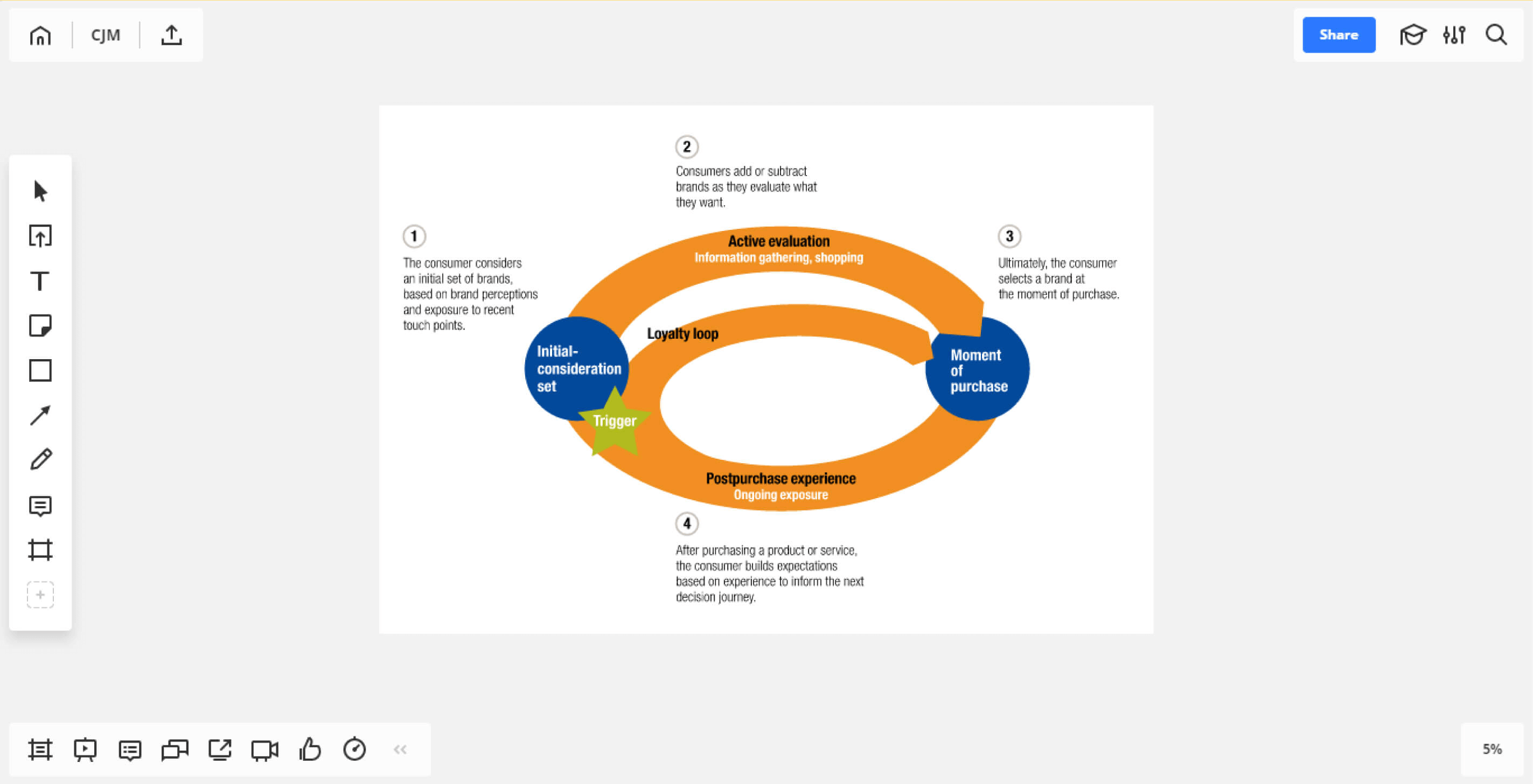
A sales automation journey map can often become quite complicated because it is not linear, and it needs to predict the path for many different personas to move from consideration to paying customer.
Fortunately, the steps are easily tracked and measured, which is why a sales journey map can help to customize marketing and sales strategy. It can be used to determine which scenario converts customers more frequently and which drives the biggest income from a single customer. The biggest difference from the customer journey map is that the sales journey map does not consider the product at all, merely the marketing needed to connect with the customer.
3. Service blueprint
A service blueprint is a visual tool designed to establish effective business processes. Just like product companies use blueprints to help them construct products and buildings, service businesses use blueprints to ensure all the factors are in place and the processes optimized to provide great customer experience. The service blueprint provides a visual for the person providing a service to see the steps in the process that they need to accomplish behind the scenes.

Since it focuses on the process as opposed to the experience, a service blueprint shows the backstage of the Inside-out world, but will have a lack of information on user experience. Fortunately, a customer journey map covers this problem (mapping the user experience), and these two diagrams are often aligned. In this case, the customer journey map describes a user and acts as a step in the decision cycle, while a service blueprint captures the flow of all business processes impacted by the journey.
4. Process map
The process map is very similar to the service blueprint — it maps the process activities flow, plotting out responsibilities, business standards, and KPIs or success indicators . It’s necessary to map processes if you want to train the staff to a single standard, identify opportunities for improvements or assess the influence of any upcoming changes.
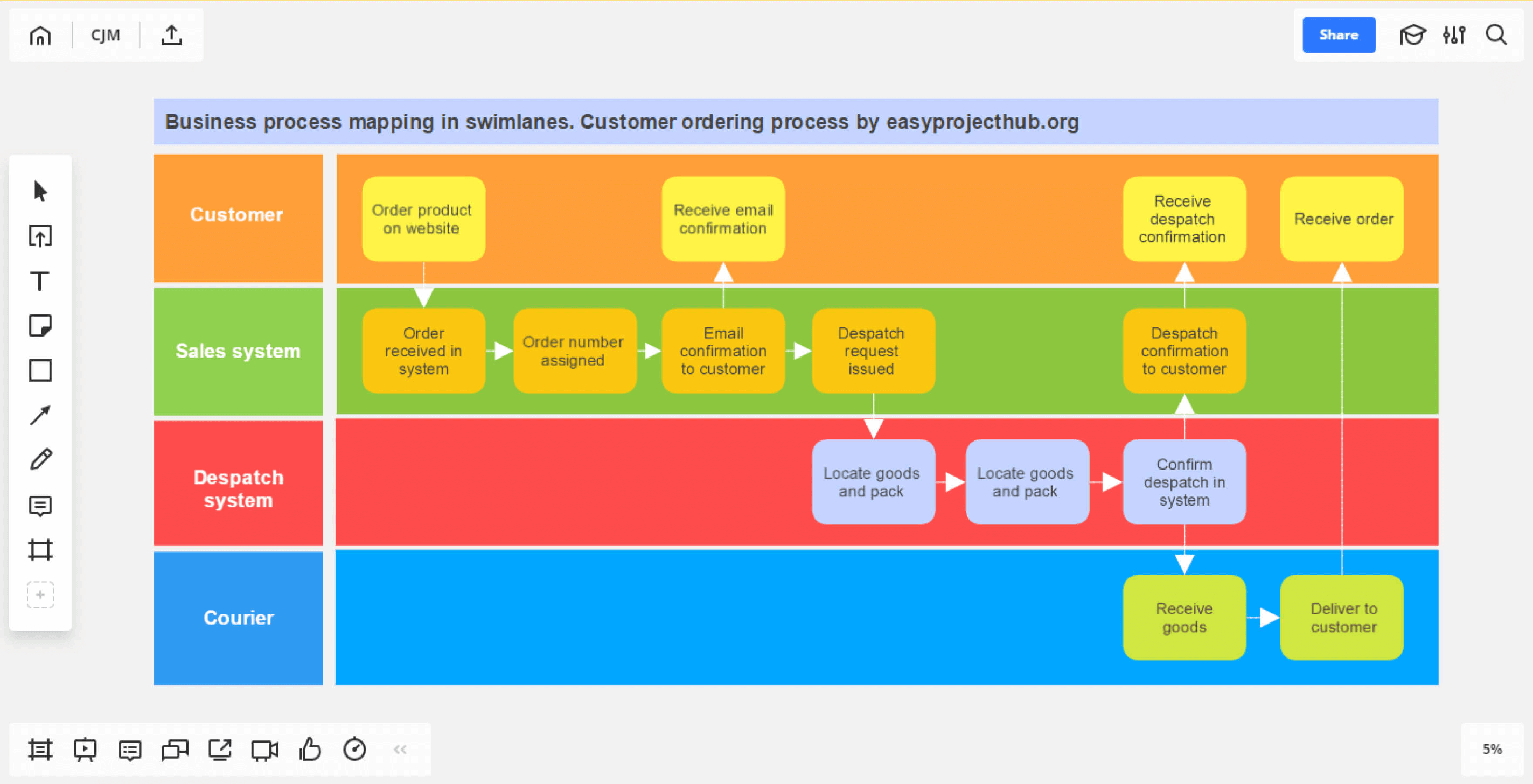
A process map is often developed by specialists or by specific departments because it is important to have expertise in the internal process. This is different from how a CJM should be developed; since a customer journey map is not focused on the internal world, the team can (and should!) be cross-functional, representing all departments involved in the customer experience.
As you can see, any of the diagrams mentioned above could positively influence UX and CX, and the most powerful journey map combines all of these types of maps so that the internal perspective will be developed in conjunction with an understanding of the customer journey.
The most powerful journey map combines all of Inside-Out and Outside-In maps so that the internal perspective will be developed in conjunction with an understanding of the customer journey.
The most common mistakes while customer journey mapping
When developing a customer journey map, many companies that are eager to make use of a powerful tool fall prey to some common and easily correctable mistakes:
Customer journey map is an old document with restricted access
Customer journey map is a single linear path..
Flexibility is the key to great customer experience. Recreating a linear path of the customer experience is a waste of time because customers take many routes to complete a sale .
Customer journey map skips some touchpoints
considering them as occasional or unimportant. To make your map as useful as possible, you need to include every point where your customer comes into contact with your business. According to research from McKinsey & Company, the number of touchpoints is increasing in number by around 20% a year . Do not forget about social media channels, collision touchpoints , and the post-purchasing period!
Customer journey map is created from the company point of view
If you interpret your customer’s experience, you will wind up in a situation where you shoot in the dark because the chances that you guessed right are next to zero. Let the information speak for itself.
One customer journey map for all customers
Each customer persona is unique. You may wish to group them according to research results, but each group requires a dedicated customer journey map.
Customer journey analysis concentrates on the bad experience
It’s true that pain points are vital opportunities to dramatically increase customer satisfaction, but don’t forget to figure out your success points. These play an important role in emotional decision making, and extending the positive experience is an opportunity, too.
Customer journey map doesn’t include an action plan.
The gaps between the desired customer experience and the one actually received should be your action plan. Set it as a clear expectation of the result — each participant of the workshop should understand it. Then, carry the vision through planning and execution. Don’t neglect this! There are two ways to work with the gaps and barriers: improve the touchpoint or remove it from the process. If you let the situation flow as it is, it will turn out in the frozen or decreasing AARRR metrics because many disappointed users will continue silently leaving. And don’t forget that any successful changes conсern three angles of the process (not one) — customers, business processes, and corporate culture/structure.
A customer journey map is a powerful tool which, if used properly, positively influences customer experience, which in return improves retention and revenue metrics. Although it is not a magic bullet that can solve all your experience problems at once, it helps to add value for your customers.
The tool itself is rather complicated because it deals with behavioral patterns of different audiences and requires discipline. Trying to make the path simpler is tricky because it usually leads to the above-mentioned set of most common mistakes, like creating a CJM from the company perspective.
In Miro we decided that three simple rules make the customer journey map more effective:
Feel free to customize the process of the customer journey mapping and improve it from one revision to another.
Since this article is a collection of best practices across the web and Miro experience, we welcome you to share your thoughts, cases, and references in the comments below! Or check out the links to related templates (like Persona) and other useful links below.
Related templates and links
While creating the customer journey map, the following templates can help you make the process smoother. Use all of the templates together with the customer journey map on one endless online board to get a helicopter view of the problem.
Useful links:
1. Outstanding customer journey mapping toolkit with several templates ;
2. UX Project Canvas Template ;
3. Practical Service Blueprinting Guide .
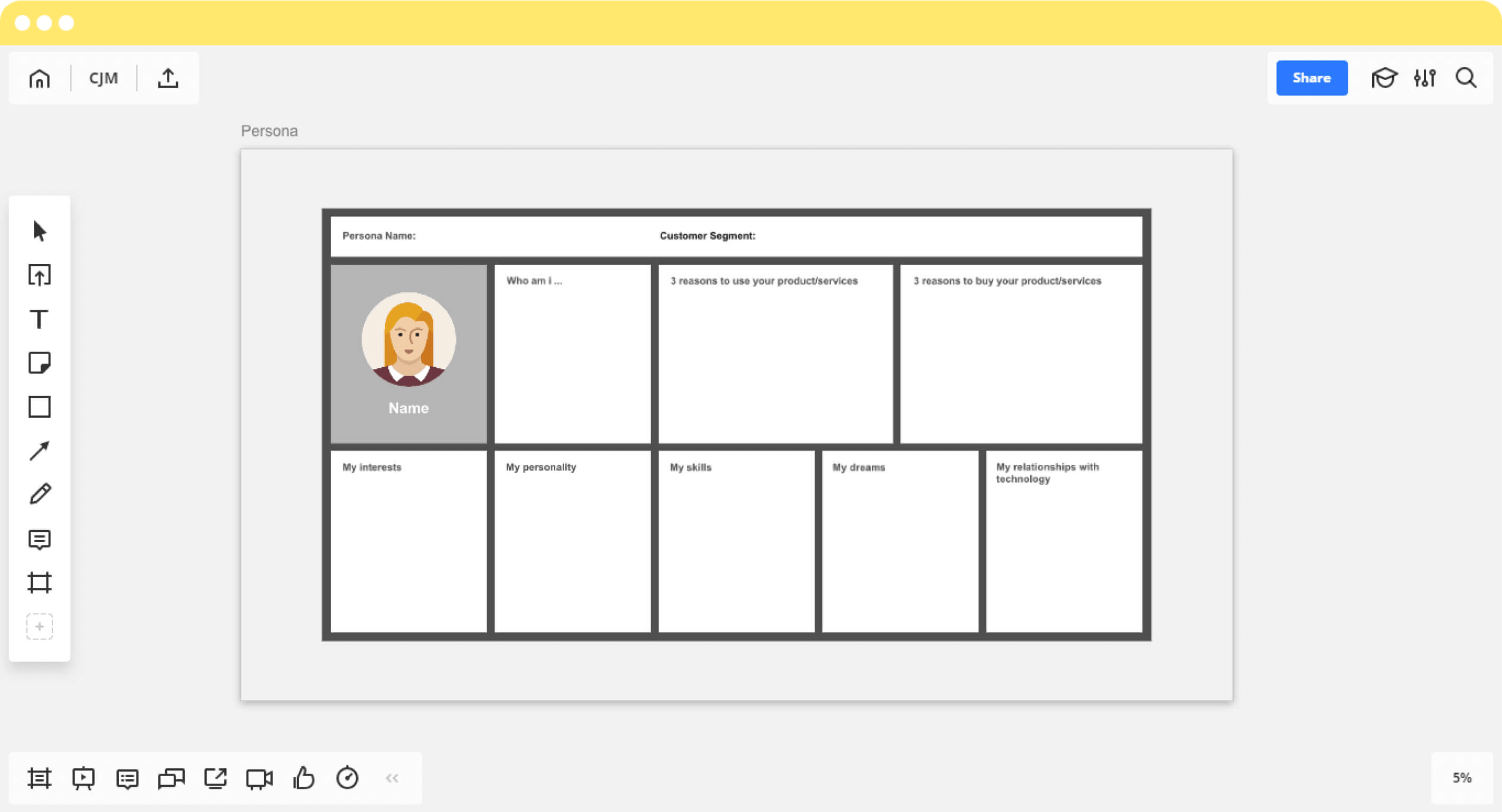
Miro is your team's visual platform to connect, collaborate, and create — together.
Join millions of users that collaborate from all over the planet using Miro.
Keep reading
Summer kim on the best ways to approach user research.
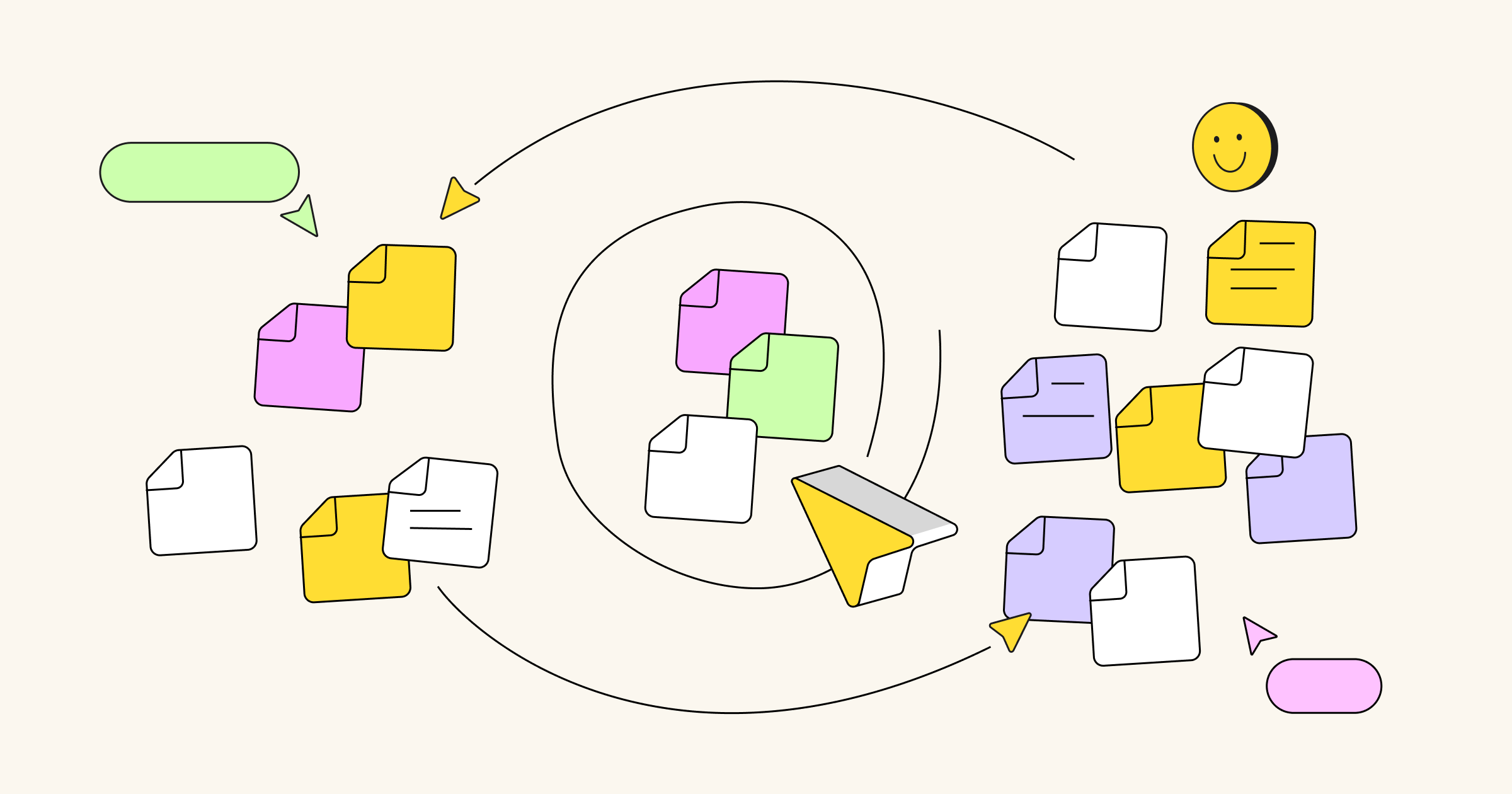
Ben Holland-Arlen on how the Salesforce UX team is working remotely
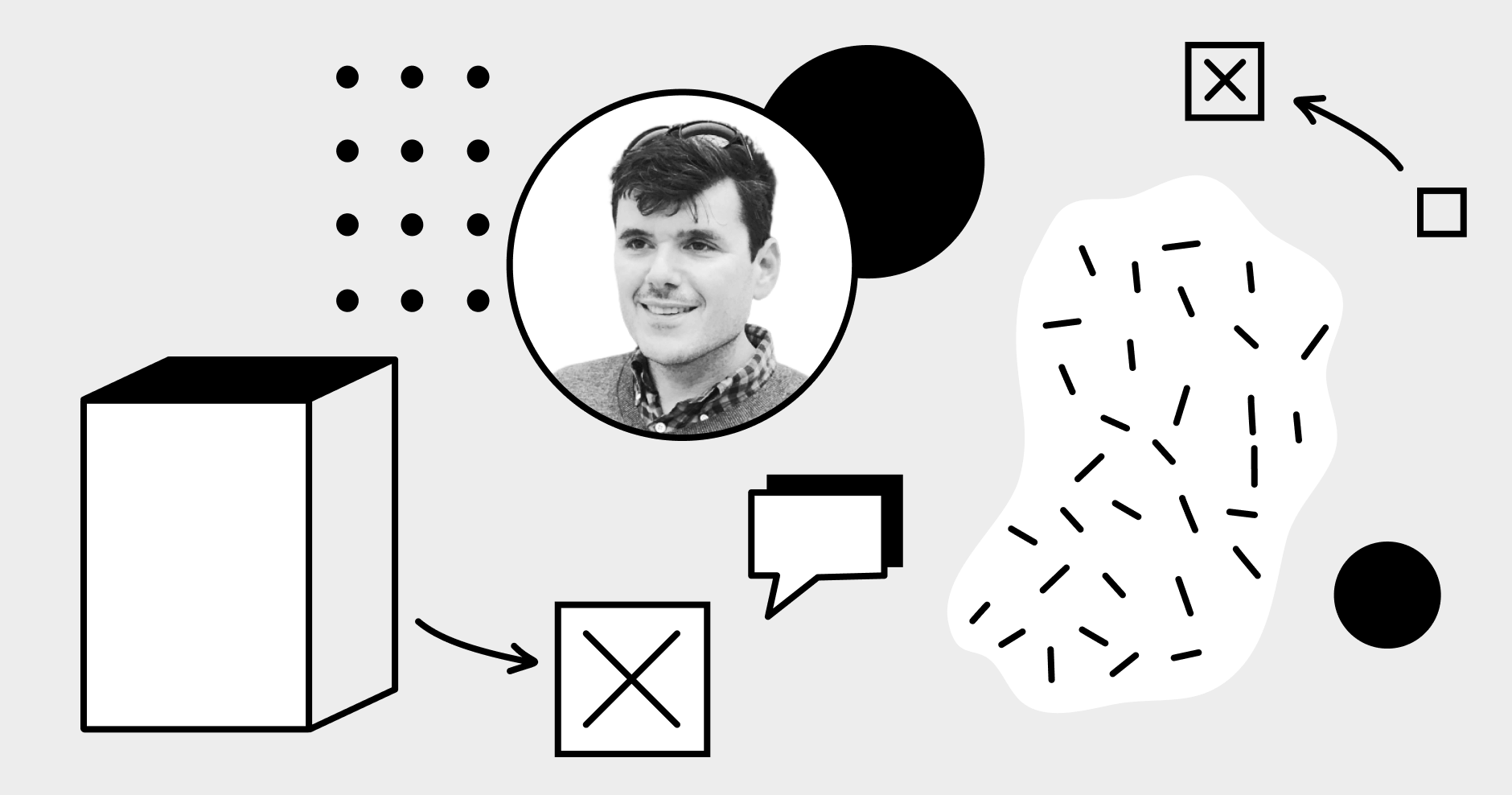
Aloka Penmetcha, Pivotal: “Find mentors who can tell you what good looks like”

User Experience Journey Mapping: What Is It and How to Create Your Own Map?
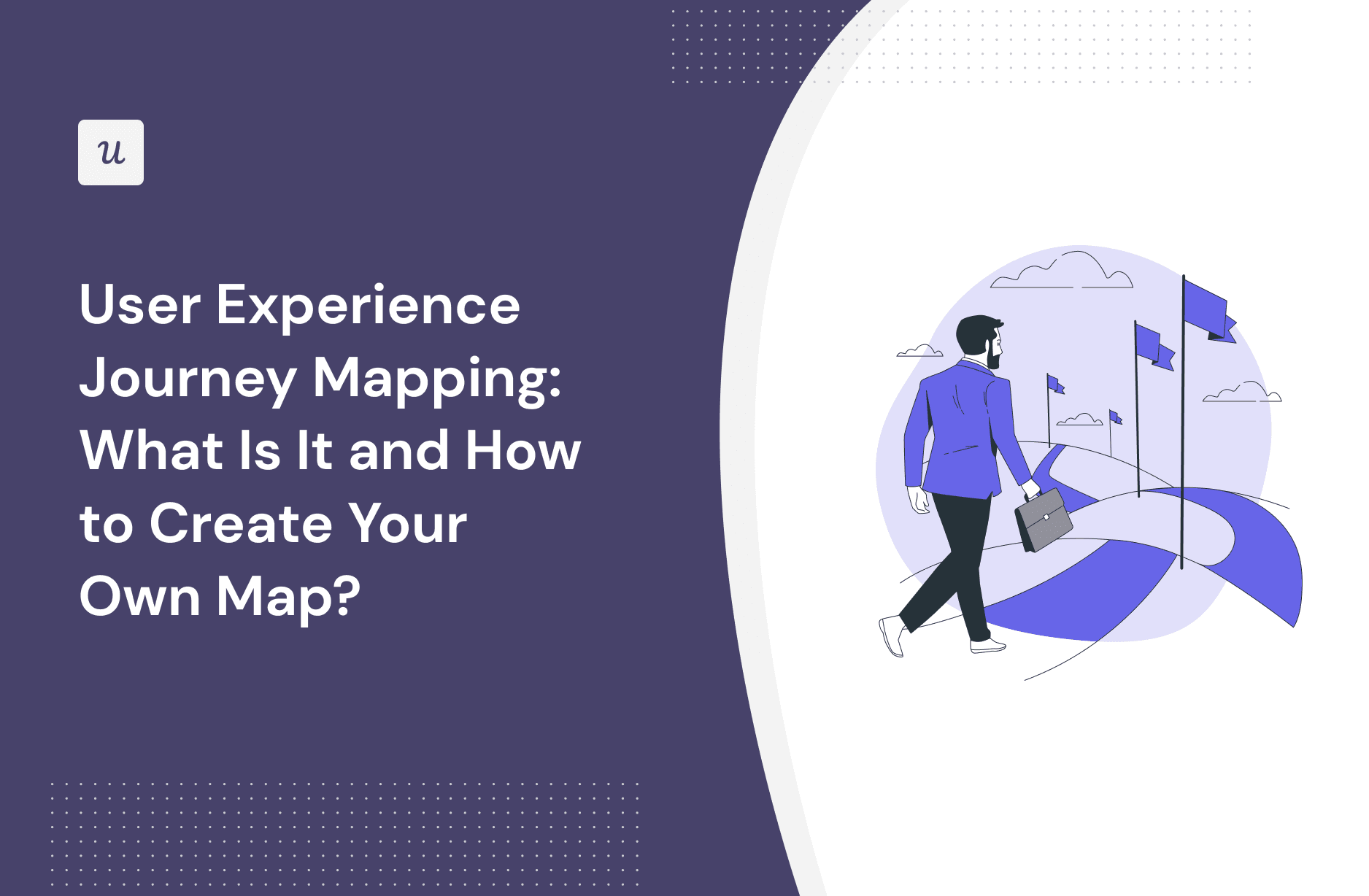
How can user experience journey mapping help teams design engaging products?
This is one of the questions that the article tackles. We also:
- Explain what UX journey maps are
- Outline the main benefits of user journey mapping
- List key journey map elements
- Show you how to create a user journey map for your SaaS product
Let’s dive in!
- A UX journey map is a diagram outlining user flow through the product, from the moment they first find out about it till they achieve their objectives.
- User experience journey mapping helps teams better understand their users and the challenges they experience when using the product.
- Insights gathered when mapping out user journeys can also help teams build frictionless user experiences which lead to higher product adoption and customer retention.
- User personas represent key user segments and provide information about their JTBDs , demographics, professional backgrounds, goals, and needs.
- The journey map consists of a few main stages, like acquisition or adoption, each with its unique goals.
- During each of the stages, users interact with the product at different touchpoints and experience different emotions. All this also goes into the customer’s journey map.
- The journey map also includes information about user pain points at each of the touchpoints and possible solutions.
- The first step in the user experience journey mapping process is defining the user personas .
- When you know who your user personas are, identify relevant touchpoints for each of them. Product analytics tools like path analysis can help with that.
- Next, collect quantitative and qualitative data about user experiences at the various touchpoints to identify their pain points and expectations.
- Use a template , for example, from Canva or Miro, to create the map.
- After that, reach out to your users and invite them to participate in interviews, focus groups, and usability testing to validate your user map.
- User experience journey mapping is an ongoing process. Constantly update it as new data emerges from user feedback and analytics.
- Userpilot is a product growth platform that you can use to research user personas, analyze user interactions with the product, and improve user experience with UI patterns . Book the demo to discover how!

Try Userpilot and Take Your User Experience to the Next Level
- 14 Day Trial
- No Credit Card Required

What is a UX journey map?
The user experience journey map is a visualization of all the user interactions with the product from the moment they first learn about it until they achieve their goals in the product.
The purpose of a UX journey map is to help teams better understand the user experiences and emotions at different stages of the user journey and guide their work to refine the UX.
Why is user journey mapping important?
Customer journey mapping is a key tool in the UX and CX design process for several reasons.
Here are a few of the most important ones.
Helps to understand user behavior on a granular level
The journey mapping process gives teams in-depth insights into user behavior.
By looking closely at how users interact with the product at all touchpoints, you can better empathize with your customers and understand their needs , motivations, and pain points.
All of these are essential for building products that genuinely meet user expectations and help them achieve their objectives.
Creates frictionless customer experiences
By outlining all user interactions at different touchpoints, user journey mapping helps teams design frictionless customer experiences.
For example, you may be able to identify steps that are unnecessary for customers to complete or areas where they face difficulties. That knowledge allows you to address potential issues proactively and streamline the user experience.
Increases product adoption and customer retention
By smoothing out the user journey, you help them reach the next stages, be it product activation, adoption , or advocacy.
This translates into high user retention rates and customer lifetime value , and consequently helps you achieve your business goals.
Key components of a user journey map
What are user journey maps made up of? What kind of information do they contain?
Let’s explore.
User persona
User personas are fictional characters that represent different types of users that help you empathize with your target users and better understand their needs.
The odds are that your target audience is not a homogeneous group. For example, a performance and fitness platform tool like TrainingPeaks caters to coaches as well as athletes.
As these two types of users have different goals and use the tool differently, there are two UX journeys to map out.
Context and user goals
Talking of goals, your user journey map needs to include what each user persona wants to achieve in the product and the contexts in which the product is used – both real and anticipated ones.
For example, a coach uses TrainingPeaks to develop training plans for their athletes and track their performance, while the athletes will use it to access the workouts, record their workouts, and share them with their coach.
If you’re developing a new functionality, for example, adding an AI-powered feature that enables you to forecast athletes’ race performance, you will need to map out a new journey.

User journey stages
User journey stages are the core element of the map – everything else is organized around them.
What stages are we talking about?
Some classic examples include:
- Awareness – the user finds out about the product
- Evaluation – they start considering it as a possible solution to their problem
- Acquisition – they sign up for the free trial or purchase the product
- Activation – they experience product value firsthand and start realizing it
- Adoption and retention – the user starts using the product regularly as their go-to solution
- Advocacy – they start promoting their product in their social and professional circles
The stages are most likely to be the same for all user personas but what happens at each stage may differ dramatically.

User actions and emotions
To be of any use for optimizing the UX, the journey map needs to have information about user actions at different touchpoints.
For example, this could be clicking on the banner advert at the awareness stage, submitting a demo request at the evaluation stage, or completing an onboarding checklist during activation.
It doesn’t stop there.
Apart from the actions, your map should also include information about the associated emotions , like curiosity when clicking on the ad, confusion when watching the demo, or excitement when logging in for the first time.
Pain points and opportunities to improve the customer experience
The journey map should also contain information about the customer pain points that users experience at different stages and potential solutions.
These are your opportunities to improve the UX/CX, which is one of the main goals of the exercise.
How to create your own customer journey map?
Now that we know what the UX journey map is and what elements to include, let’s create one. Here’s how.
1. Identify the personas to include in your own user journey map
As you may expect, identifying and creating user personas is the first in the process. This narrows down the scope of the map and gives it focus.
What information should you gather about your user personas?
Let’s have a look at our template.
It includes details about:
- Jobs to be done /goals
- Company details
- Pains and challenges
- Team collaboration
- How they can benefit from using your product
Don’t worry if don’t have all the information at hand at this stage. As you research their behavior later on, more insights will emerge.
Pro tip : to help your teams build a connection with your customer persona , give them a name and a photo.

2. Identify key touchpoints in the user journey
Once you have identified the user personas, it’s time to define their main customer touchpoints at each stage of the journey.
For example, at the awareness stage, it could be all your PPC ads or social media posts. At the acquisition stage, the sign-up form , and at the advocacy stage – the in-app messages promoting your referral scheme.
Start by listing all the touchpoints that you can think of.
Next, use analytics tools to add all the touchpoints you have missed. Useful tools for that are path analysis and session recordings, as they show you all the actions that users take on a page or inside the product.
The point of this exercise isn’t to list all possible paths that users may take but the most likely or common one.
3. Conduct user research to note their pain points and expectations
With all the touchpoints listed, it’s time for a bit more in-depth research .
Qualitative research is particularly important as it allows you to understand why users behave in a particular way and what challenges they experience.
You can get this data from:
- User interviews and focus groups
- User observations – either live or by watching session recordings
- Conversations with the customer-facing teams – your colleagues from the sales or customer support team engage with customers daily and have lots of anecdotal information about their pain points and expectations
- Social listening – for example, user comments on social media or forums
- In-app and email surveys – these could be general, like CSAT , or touchpoint-specific and triggered contextually

Quantitative data comes from web and product analytics tools. Common types of analysis that you can use to identify bottlenecks in the user journey include:
- Funnel analysis – to identify the stage in the user journey when the user experiences friction
- Heatmap analysis – to identify specific UI elements where the user struggles.
4. Use a user journey map template for visual representation
The easiest way to create a customer journey map is by using a template . There are plenty of these available so there’s no point reinventing one.
Here are links to a few solid ones:
Canva Doodle Sketch customer journey map template
Miro customer journey map template
Figma user journey map template

5. Validate your customer journey maps through user feedback and testing
Even if your research is robust, the UX journey map is only what you think happens, not necessarily the actual user’s journey. To make sure your map accurately reflects the real experiences of your users, you need to validate it.
This involves using similar methods to those you used for researching user personas, so quantitative user behavior analysis , interviews, focus groups, and usability testing.
To recruit participants, reach out to them in-app, for example, by triggering a slideout, like this one.

Choosing the right participants isn’t so straightforward.
Your power users might seem the obvious choice, partly because they are the easiest to recruit, but they might not be the most representative sample. They’re the most successful users, after all, so they may not share the same pain points as others.
Instead, use your product analytics tool to find a wide range of users with various demographic characteristics.

6. Continuously update and refine your user journey maps
UX journey mapping isn’t a one-off activity.
As your customer needs, the competitive landscape change and your product evolves, so do user interactions, rendering the map obsolete and inaccurate.
That’s why it’s essential to update your user map regularly.
Monitor product analytics for changes in interaction patterns, constantly collect customer feedback, conduct ongoing user research, and tweak the journey map as you go.
Instead of big occasional updates, make it an iterative process.
User experience journey mapping allows teams to understand their user and their interactions with the product. The map also guides UX improvement and helps provide a consistent experience at all stages of the journey.
If you want to see how Userpilot can help you collect the data for your user journey and validate it, book the demo!
Leave a comment Cancel reply
Save my name, email, and website in this browser for the next time I comment.

Get The Insights!
The fastest way to learn about Product Growth,Management & Trends.
The coolest way to learn about Product Growth, Management & Trends. Delivered fresh to your inbox, weekly.
The fastest way to learn about Product Growth, Management & Trends.
You might also be interested in ...
21 code-free ux tools for saas product teams.
[email protected]
User Experience Optimization Guide For SaaS: Steps and Techniques
Aazar Ali Shad
Navigation UX: Pattern Types and Tips to Enhance User Experience
- Skip to main content
- Skip to primary sidebar
- Skip to footer
- QuestionPro

- Solutions Industries Gaming Automotive Sports and events Education Government Travel & Hospitality Financial Services Healthcare Cannabis Technology Use Case NPS+ Communities Audience Contactless surveys Mobile LivePolls Member Experience GDPR Positive People Science 360 Feedback Surveys
- Resources Blog eBooks Survey Templates Case Studies Training Help center
Experience Map: Importance, Elements and Benefits
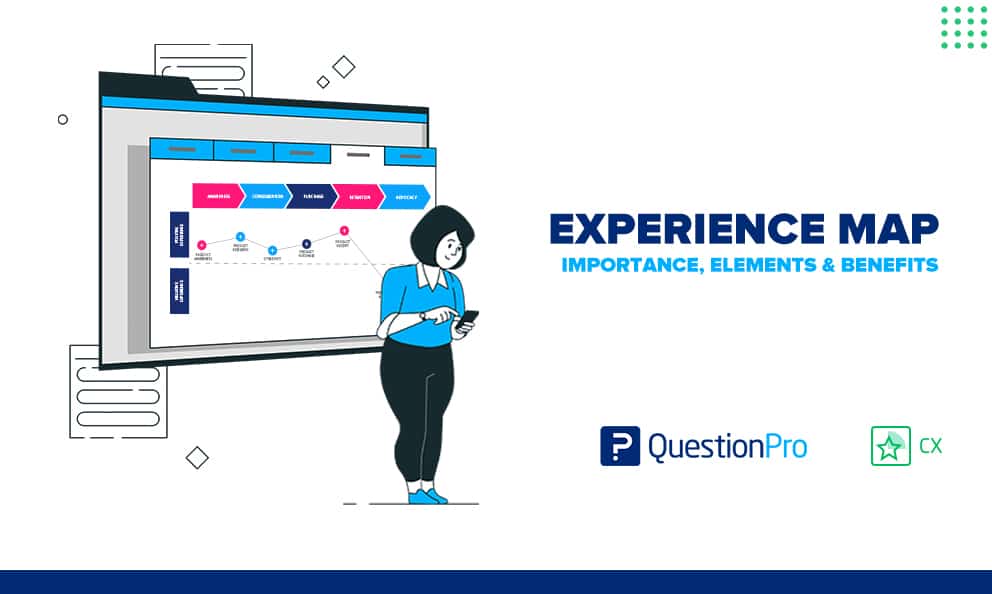
You might think a customer experience map is not practical or useful for your company. Why do we need another customer experience map when we already have the customer journey map, right? Not exactly. In reality, the cases of success using this tool continue to increase.
Why? Because the experience map gives us a general understanding of a customer experience . Therefore, it has become a great addition to many companies’ processes and strategies, reflected in their overall product sales.
In a competitive environment like the current one, managing a customer experience map will put you one step ahead in the “race” to generate value for your customers and differentiate yourself from your competition along their customer journey .
The design of the customer experience is key to the management of service since it will allow us to know what customers feel, what they expect, and what motivates them to buy.
But the big question arises: how do we map the customer experience? To identify the moments that a customer lives with your company, along with the points of contact and opportunities for improvement, you must use the customer experience map widely used in organizations to understand their customer journey further.
In this post, we will go over the experience map definition, the main differences between the Customer Journey Map , why it is essential, its elements, and its benefits. Happy reading!
What is an Experience Map?
An experience map is a visualization of a complete end-to-end experience mapping experience that a “generic” person goes through to achieve a goal.
This experience is agnostic to a specific business or product. It is used to understand human behavior in general.
Remember, the customer experience reaches all interactions: from attraction to loyalty. Also, you should know that its scope is holistic, uniting the business around the customer’s vision.
Although your company cannot completely control the customer experience because it implies mastering perceptions and emotions, it can be prepared to offer WOW experiences and correct what needs to be rethought.
Experience Map vs. Customer Journey Map: Is there a difference?
Yes, there is! But the truth is, they can be easily mixed up. The confusion is given because both maps are usually divided into similar lanes: phases, actions, thoughts, and emotions. So, visually, companies tend to think they are interchangeable concepts. Fact is, there is a silver line between both concepts. Let’s review them.
The Customer Journey Map represents a client’s path in their interactions with the company.
The latter allows the customer’s relationship with the company to be understood, identifying goals, objectives and activities they carry out along their journey.
The tool helps us understand the business from the customer’s point of view, aligning the teams to prioritize actions after the experience.
Learn More: Customer Journey Benefits
Having introduced both concepts’ definitions, the main difference is that the customer journey map is way more detailed and focused on a specific business or product within the company.
In comparison, the experience map is wider and instead of focusing on one specific buyer persona, it goes through the whole customer experience in a more holistic view.
Companies usually trace the experience map first and then the customer journey map. We get the general vision of what our customer’s experience is
The experience map is characterized by:
- Representing events in chronological order
- Not tied to a specific product or service
- Offering a general human perspective of their experience with your brand and other businesses
On the other hand, the customer journey map is:
- Tied to a specific product or service
- Reflects on the customer perspective (including the way of thinking, thoughts and emotions)
- Creates a map for each buyer’s persona
- Connects to a client’s objective achievement
Learn More: Customer Journey Examples
Why building an experience map is worth it?
If we want to provide a better customer experience, the best way to know what they need will be through the collection of information in the form of:
- Customer surveys
- Focus groups
You can view and use our sample customer survey templates in your organization; they are ready to use.
It is essential to learn how to do a research market study, since it will give you the necessary tools to learn more about this type of function. To create a customer experience map, research is vital.
That is why old assumptions and what we “think we know” about our client (without reviewing) are two things you should leave behind. Only then will you be able to create an ideal customer experience.
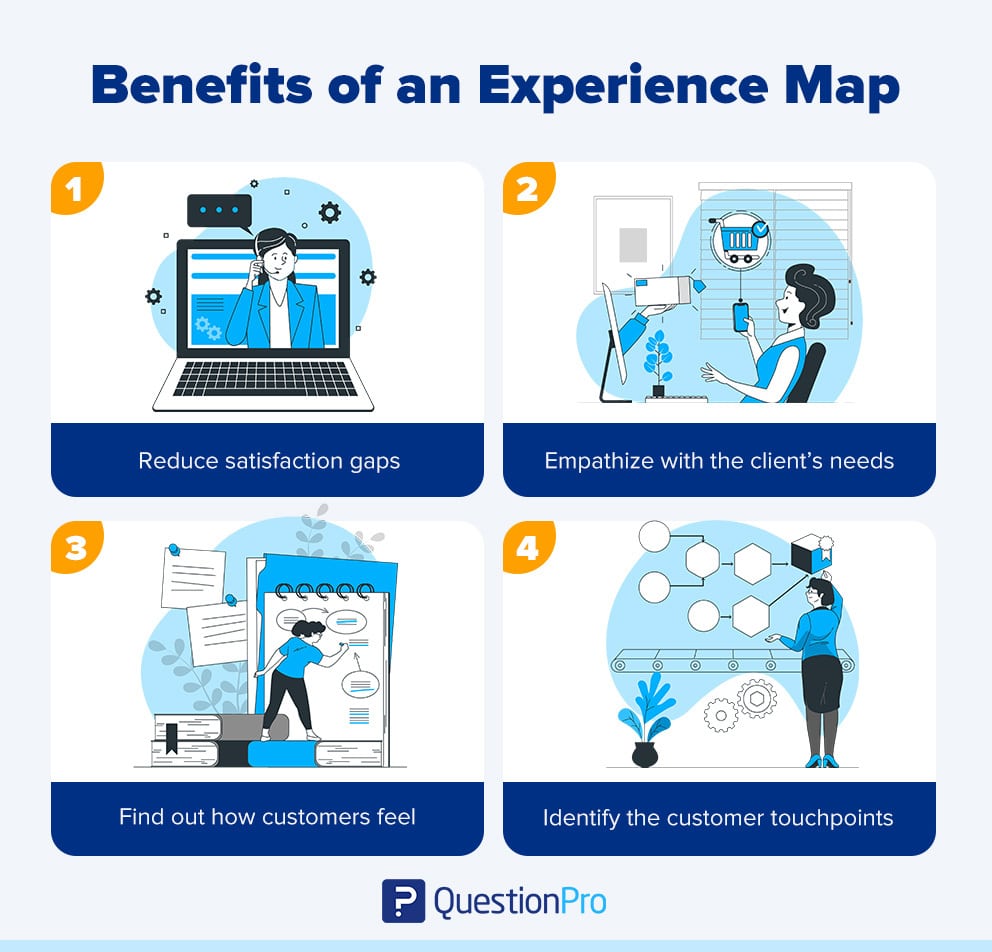
Learning to make a customer experience map is crucial since you will be able to execute the following actions:
- Reduce satisfaction gaps
Making a customer experience map will allow you to identify gaps between what you offer as a company and what your customers expect from you. If you don’t, your competition will likely improve and, before long, you’ll wonder: where did my customers go?
- Empathize with the client’s needs
When you conduct market research on your customers, ask them about the experience attributes they value most. This is key to offering your customers the WOW effect in the consumption experience.
To conquer customers, the idea is to learn to create experiences that leave them speechless.
Remember that there are also customer pain points . These unsatisfactory moments must be analyzed through a customer experience map as part of the customer touchpoints.
This helps to prioritize solutions depending on the level of influence they have on the overall experience.
- Find out how customers feel
Using a customer experience map, you will know how they feel at each point of contact with your company. This will enable your team to work on common issues and build unforgettable moments.
- Identify the customer touchpoints
The touchpoints are moments when the client communicates with the company before or after consuming your articles and services. They are fundamental elements in designing the customer experience map.
What should you consider to find the points of contact with your client?
This is what any company should keep in mind:
Contact before locating your business: at this point, ask the client how they found your business.
Contact while they are in your business: here, you should inquire about why they are visiting your business. That is, the reasons he had to approach and the need that led him to that point.
Contact after buying in your business: the final meeting, in which you find out how the customer’s buying experience and their encounter with the business was. Dig into whether they were able to resolve your issue or if they provided good customer service, for instance.
Keep in mind that customer loyalty and the recommendation of your brand to more people (word of mouth) will depend on these points of contact.
If you like reading about what is an experience map, you might find it interesting learning about customer journey vs customer experience: the difference .
What benefits does the customer experience map provide to a company?
We cannot discuss the customer experience map without evaluating this type of resource’s benefits for the company in question.
According to recent studies, if you analyze the impact that managing the customer experience has had, companies can obtain:
- 24.9% average year-over-year increase in progressive revenue from marketing campaigns
- A 21.2% reduction in service costs
- 16.8% of the sales cycle
This is what managing the right customer journey produces. But, beyond the figures, drafting this type of plan offers endless opportunities for your business, such as:
- It can increase the degree of commitment and customer loyalty by optimizing channels.
- You can eliminate the friction located in customer touchpoints.
- Transition from a company-focused perspective to a more customer-focused one.
- Close any type of interdepartmental gap that exists in your company.
- Target average users of specific customers, having appropriate marketing campaigns for their identity.
- Understand the circumstances that could generate irregularities in some specific quantitative data.
- Develop an ROI evaluation of future investments regarding the consumer’s user experience.
LEARN ABOUT: User Experience Research
These are some of the advantages offered by having this type of resource at hand. If you want to see your customers’ emotions about your company improve, bet on creating a customer experience map.
Read about the consumer decision journey .
What elements should the customer experience map have?
First of all, certain events can happen before, during, and after a customer’s interaction with your brand. So, the customer experience map can vary in the contact points and channels and not have the same duration length.
Several aspects of the customer experience map are vital, as they will help better understand how this tool can serve your business. Let’s review them:
This element of the customer experience map will help you understand the consumer according to the actions they take or intend to take concerning your product or service.
To further understand this point, ask yourself the following questions:
- What is your client doing?
- What makes the customer not advance to the next stage of the purchase process?
- What are the actions that a client needs to move forward?
Answering these questions is crucial to understanding the role of this element in the experience map.
- Motivations
This point of the customer journey map is based on what is behind the action: the intention, the feeling that drives the public to make a decision or, at least, consider executing some activity.
In other words, it is about what could drive a customer to move to the next point on the experience map. It is also important to give reasons for this decision’s objective.
Is it about solving a problem or need of this client? It is imperative to know what they are experimenting with your brand, to help them fix their issue or enhance an already good experience.
It is related to the previous points of the customer experience map. Questions are crucial to knowing the matter to be addressed and the target to be aimed at.
Some of the questions to which we are referring are the following:
- What are the doubts and questions that the client has?
- Do you need or are you looking for a particular product/service?
- Are you confused about the purchase process or the product in question?
The secret is in the fact of beginning to recognize the phase in which the consumer may have more questions and can answer them more clearly.
- Critical points
These elements are essential to designing and executing the customer experience map needed for your business. Pay attention to the little details, and don’t miss the opportunity to devise the best plan.
The critical points we refer to include elements related to the company and the ease you can offer the client during their experience. For example:
- What are the obstacles that prevent clients from being able to advance to the next phase?
- What is the buying process like for them?
- Is the price accessible?
Those are the elements of the customer experience map that you cannot miss when designing this project.
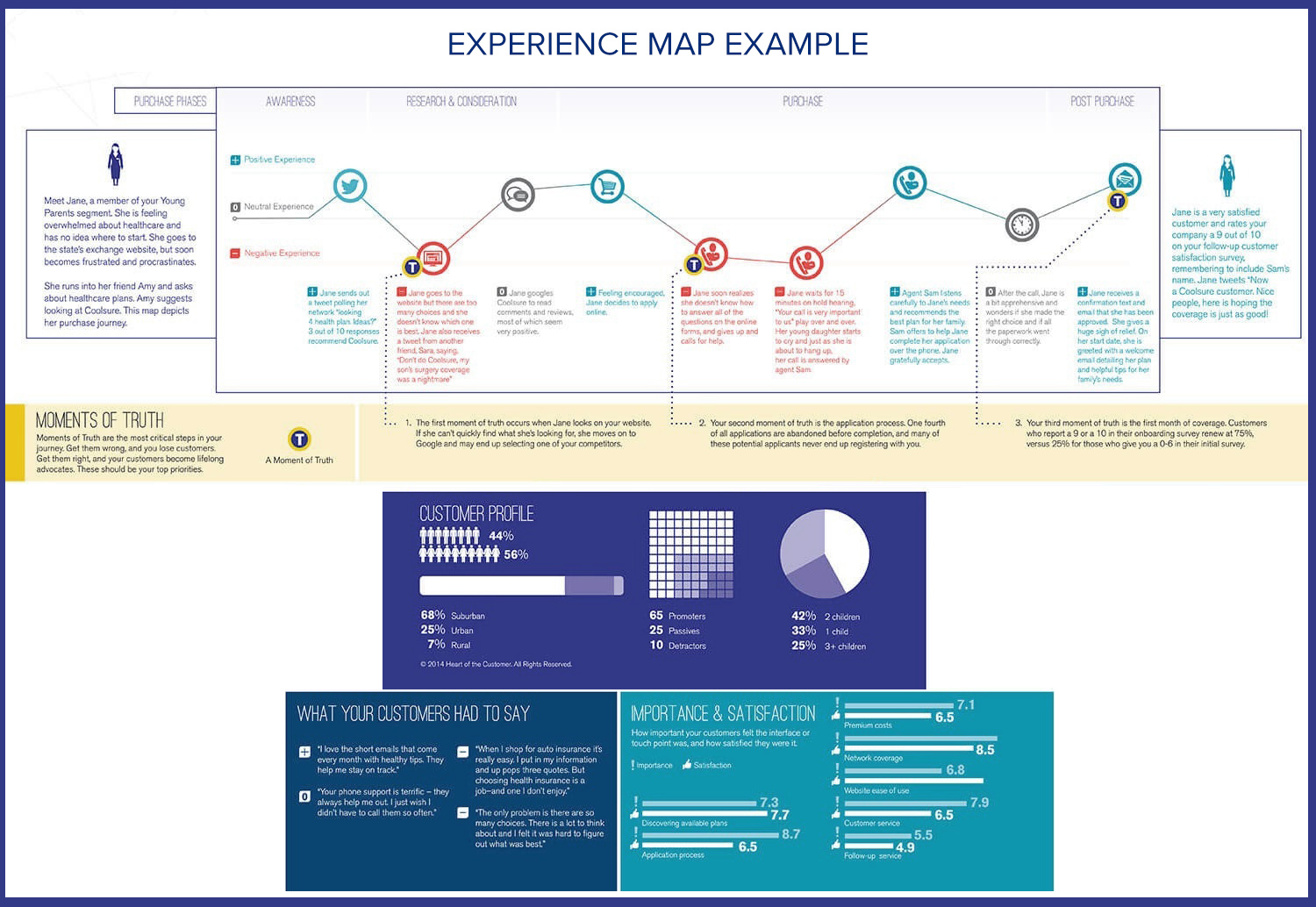
LEARN ABOUT: Customer Experience vs. Customer Service
How to map the customer experience?
Being a versatile tool, its use has diversified. The idea is that the means for customer experience management adapt to your company and not the other way around .
The following are the essential steps to designing your first customer experience map:
- Identify your customer
At first, you should analyze who your client is. And the truth is that your company can have multiple types of customers. However, with the experience map, you should be focusing on one overall generic customer profile.
Focus on understanding, in-depth, what their motivations and expectations are. You must go so deep that you must know how your customers think and feel.
Once you’ve identified your customer’s general profile, it’s essential to understand their motivations and expectations.
If you are planning on creating next the customer journey map, we recommend this customer journey canva template if you want to know what questions you should ask your customers to segment them.
DOWNLOAD TEMPLATE FOR FREE
- Be aware of the critical moments of the experience
To understand what your customers think and feel, you need to know what touchpoints they experience before, during, and after purchasing your product or service. The customer experience map can comprise multiple points of interaction, which you must identify and manage.
A key issue is that you identify the level of influence of each point for the client. For example, if we’re talking about Starbucks, a customer might be forgiven if there were no napkins on the table. On the other hand, the entire experience could be ruined if the barista doesn’t give the customer a smile or the coffee isn’t what they expected. Imagine if they have the name of someone else on it?
- Empathize with the customer
Once you have identified the moments within the customer experience map, it is time to ask yourself: what causes the customer stress or annoyance? In that sense, you must have a deep understanding of what your client expects, thinks and feels; with the aim that you can design a value proposition that exceeds their expectations.
As we have discussed, the construction of the customer experience map is based on research and insights, not assumptions.
- Record the touchpoints
Just as you identified the WOW moments, it is time for you to record each of your customers’ interactions with your company’s products and services. Continuing with the Starbucks example, the first customer will order through the coffee app and go through the drive-thru.
In contrast, the second could walk to the cafe and order directly from the store. If we make a complete list of your contact points, it will look like this:
- The arrival at the place
- Waiting in line
- The interaction with the barista
- Placing the order
- The payment of the account
- Receipt of the order
- The use of bathrooms
- The use of the internet
- Coffee outlet
When making a customer experience map, it is advisable to map the entire experience to have a clearer view of all the customer touchpoints . Not all clients may request Wi-Fi or use the restrooms, but it is essential that you know what their experience would be like if they decide to use them.
- Design the customer experience map
Once you have identified all the previous elements, it will be time to design your customer experience map. When doing so, you must include:
- Contact points
- What the customer expects
- What the customer receives
- The way the customer feels
- Evaluate the WOW moments vs. your company’s performance
Identify the most critical moments for the client, those to which they give the highest priority when analyzing their satisfaction. In that sense, it will be key to identify which ones you are doing well and which ones are not so much.
Based on this, you will be able to define action plans for each improvement opportunity identified.
- Identify key processes
Although it is not exactly a part of the customer experience map, it is essential that you know, in-depth, the processes and the areas that participate in each point of contact.
If you want to take your knowledge to the next level, you should know another CX tool: service blueprint, which works as a strategic tool to design the service of companies and, thus, have a complete description of the parts of the provision of a service. (visible and non-visible elements).
LEARN ABOUT: Service Blueprint
- Define the metrics and KPIs
If there is something you should not forget is the measurement. To do this, you should consider the following points:
- What will be measured?
- How will it be measured?
- How often will it be measured?
- Who will be responsible?
This is the only way to find improvement opportunities in a customer experience map. For example, if you detect pain points and define action plans to improve the situation, measuring is the only way to know if you are on the right track and if your plans are working.
How do I know how many customers I have retained and how many will not buy from me again? The Net Promoter Score (NPS) is a management system that will allow you to measure customer loyalty based on a post-purchase action: the recommendation. This system is complemented by the customer experience map and is based on a single basic question:
How likely will you recommend our service/product to a friend or family member?
The customer has the best possible shopping experience should be your priority as a company. Not only to ensure an immediate sale but also to continue being a regular consumer of your products.
You are now ready to start creating your customer experience map
We covered a lot of things, so let’s go through all the key points:
- An experience map it’s used to understand customer behavior in general
- Customer experience reaches all interactions: from attraction to loyalty
- The customer journey map is focused on the phases, actions, thoughts, and emotions of buyer personas or customer archetypes. In contrast, the experience map focuses in the overall broader experience of a generic customer profile.
- An experience map helps reduce satisfaction gaps, empathize with your customer, and identify the touchpoints your customer goes through.
- Your map experience’s main elements are actions, motivations, questions, and critical points.
- Mapping your customer’s experience is a crucial part of developing your CX program, and helpful to have before jumping into a customer experience management platform software.
In conclusion, if there is a bad customer experience, users will not only refuse to return but will also influence others not to buy from you. So designing the best possible strategy with tools like the experience map could be the key to improving your customers’ experience with your company.
But that’s only the start. Once you have your experience map and customer journey map set, you can start using a customer experience management platform such as QuestionPro CX, to send your customer surveys, collect their feedback and close the loop while tracking the sentiment of your customers.
At QuestionPro CX we offer you the best tools to monitor the customer journey benefits in your organization. Contact us! We would love to team up with you to help you achieve better customer experiences!
LEARN MORE FREE TRIAL
MORE LIKE THIS

QuestionPro BI: From Research Data to Actionable Dashboards
Apr 22, 2024

21 Best Customer Advocacy Software for Customers in 2024
Apr 19, 2024

10 Quantitative Data Analysis Software for Every Data Scientist
Apr 18, 2024

11 Best Enterprise Feedback Management Software in 2024
Other categories.
- Academic Research
- Artificial Intelligence
- Assessments
- Brand Awareness
- Case Studies
- Communities
- Consumer Insights
- Customer effort score
- Customer Engagement
- Customer Experience
- Customer Loyalty
- Customer Research
- Customer Satisfaction
- Employee Benefits
- Employee Engagement
- Employee Retention
- Friday Five
- General Data Protection Regulation
- Insights Hub
- Life@QuestionPro
- Market Research
- Mobile diaries
- Mobile Surveys
- New Features
- Online Communities
- Question Types
- Questionnaire
- QuestionPro Products
- Release Notes
- Research Tools and Apps
- Revenue at Risk
- Survey Templates
- Training Tips
- Uncategorized
- Video Learning Series
- What’s Coming Up
- Workforce Intelligence
Customer journey vs Experience maps: The difference between the two, and why you need both...

Picture the scenario, a large mechanic company wants to evaluate the efficiency of their MOT service, from when customers make an appointment, to bringing their vehicle in, to collecting it upon completion.
Their best course of action would be to create a Customer Journey Map. By assessing the touchpoints which could be causing aggravation to customers, the organisation can make the necessary changes to create a smoother MOT experience and loyalty. The Customer Journey Map served the purpose for this scenario of finding out the pain points of MOT customers, however, it doesn’t really benefit the wider organisation outside of this single transaction.
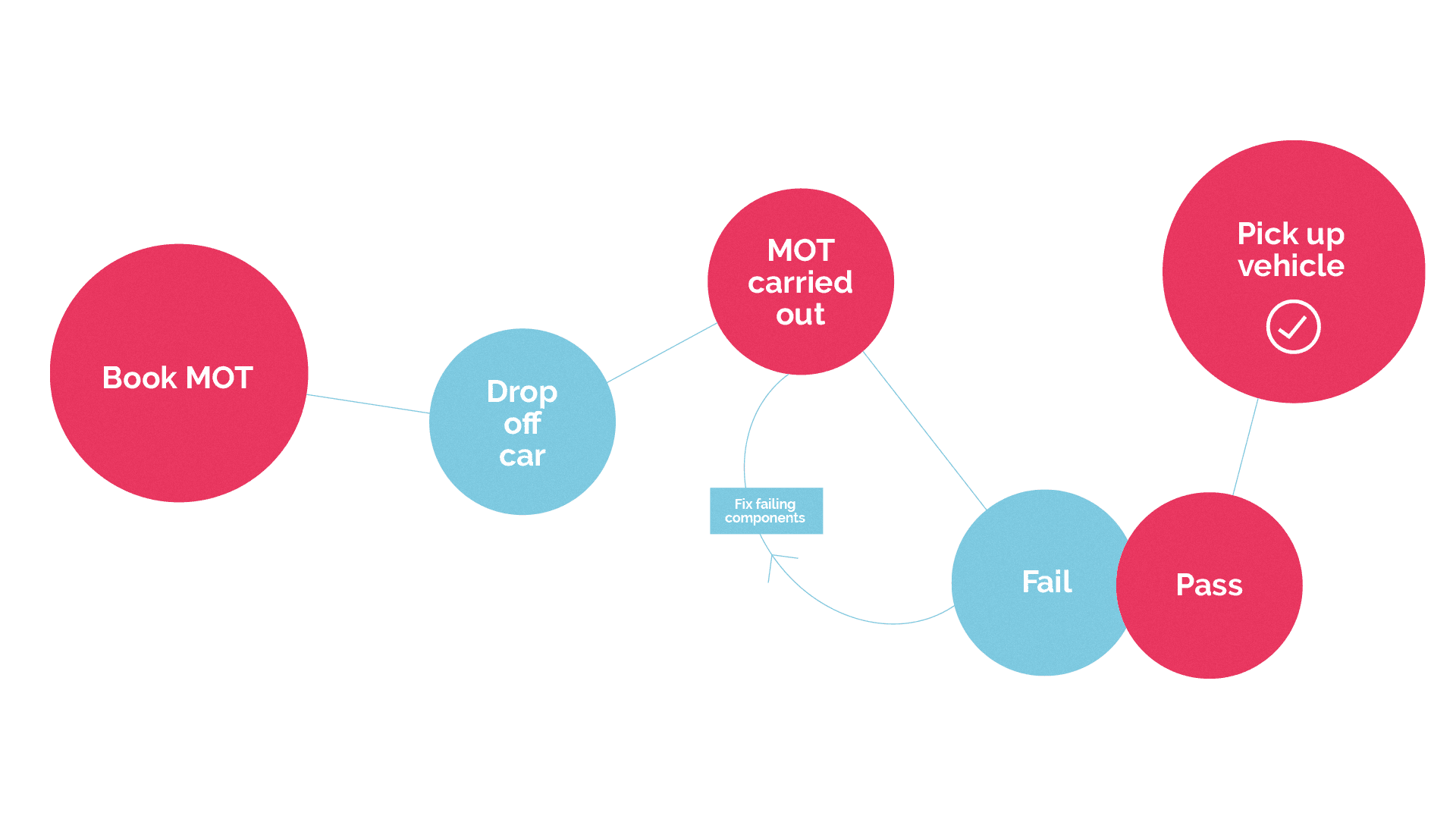
Now take this situation, a member-only Golf Club is experiencing a decline in overall membership, but the rate of new members joining has stayed the same, which is pointing to there being member disengagement at some point in their membership journey. The Golf Club is unsure at what stage existing members are leaving and what is triggering them to do so. They decide to use a Customer Experience Map to evaluate the entire member experience, which provides them with a deep, wide-ranging, insight into all their members' touchpoints and informs a myriad of changes that can be made to completely revamp their membership process and communications, and therefore maintain member loyalty.

Experience mapping and journey mapping can seem confusingly similar, and there are certainly elements in both that overlap. But there are a few very key differences to be noted when deciding if a journey OR experience map will best serve the needs of your organisation. Simply put, a customer experience map is a total visualisation of the big picture, taking everything into account that can impact a customer’s experience. A customer journey map, however, is more targeted, focused on one particular area of the organisation, or a specific transaction, and an individual customer persona.
A customer experience map is a total visualisation of the big picture, taking everything into account that can impact a customer’s experience.
Customer Journey Mapping
What is it.
Customer Journey Mapping is the visualisation of the process a customer goes through in order to get from the first stage of the buying cycle, all the way to post-purchase. The goal of the map is to determine all the potential pain points or issues that customer may be encountering. The outcome of this exercise is typically a linear diagram demonstrating the various stages a customer moves through, and the subsequent emotions they feel as they go through these stages of interaction with the company.
What can it inform?
One key feature of a customer journey map is that it can show you the exact path a customer took to get to your product, including which messages they received that were useful, and on what channels, which can no doubt be used to inform future marketing decisions. Another benefit, if not the main benefit, of a customer journey map is that you end up with a complete breakdown of how customers move through the sales funnel for a particular product/service, providing a valuable insight into where inefficiencies lie within each stage of the buying cycle. This allows the company to make small changes and tweaks, based on real evidence, and maximise the efficiency of each of these stages that the customer travels through.
When is it best used?
Customer journey mapping can be used anytime you want to put yourself in a customer’s shoes, whenever you want to know what they experience when interacting with your company or product. These are generally best used when you have a specific goal in mind, or a specific issue that you are aware of that needs to be solved. Journey maps are used when you want to zero in on a specific type of customer or persona and get a better understanding of one particular element of your business. Put simply, a customer journey map is best used if you know where you want to focus; you know where the problem lies, you just need to find out how to solve it.
In contrast to journey mapping, a customer experience map is best used if you don’t know exactly where the problem lies.
Customer Experience Mapping
A Customer Experience Map is a holistic, all-encompassing visualisation of an experience, from beginning to end, that a customer will go through irrespective of a specific product/department. These maps are more concerned with human behaviour in general; discovering more about the thoughts and experiences of a customer at every stage in the buying cycle. This is a deeper analysis than just a journey map, it could include a journey map within it, but it also takes into account experiences a customer may have outside of the journey with one particular product.
When is it best used?
In contrast to journey mapping, a customer experience map is best used if you don’t know exactly where the problem lies. You know something, somewhere is falling short, and by approaching the exercise in an honest and open-minded manner, you can hopefully nail down exactly where the customer pain points are, when before, you might not have known they existed at all. One key thing to be mindful of is that this is a customer experience map, meaning it’s got to be from their perspective, not yours or your business’s. One common pitfall to avoid is mapping out what you think the experience should be, when really, you want to map out what the experience actually is in the customer’s eyes, warts and all.
What insights are you likely to get?
- How you can optimise touchpoints with your brand
- Pain points or moments of truth in interactions with customers
- Details of website journeys
- Potential eCRM strategies
- Long term digital roadmap development
- Insights when campaign planning
- Implementation of marketing automation
Always keep in mind that this is not the same as a simple journey map, there is not necessarily only one destination.
One final thing to remember is although these maps may look like a piece of art, they are not meant to be permanent fixtures on the wall, they should be regularly reevaluated and updated. If you aren't going to rework the map at a later date to measure your progress, it’s probably better not to bother creating one in the first place.
If you want to learn more about how to make the most of these maps read our step by step guide here

Contact us:
+44 1926 652 832
More insights you may enjoy

User Experience
Three member research tools to supercharge your retention and acquisition

Your forgotten website user

V antage Point
brought to you by Freestyle
Stay relevant, with Vantage Point.
Sign up and disrupt! A monthly newsletter bringing you considered view points, opinions and thinking on the latest trends, challenges and opportunities businesses like yours are facing. Benefit from insider tips and valuable insights from digital transformation specialists.

The Ultimate Guide to Experience Mapping
Planning your experience map, how do you plan for an unplannable world.
If the last 20 years have shown us anything, it’s that trying to prepare for the future is a fool’s errand. We can only see so far. We (meaning businesses, organizations and everyone in-between) think technology causes change. It doesn’t. Instead, change is driven by how people use technology - often in different or unexpected ways. Because we scramble to predict the future, we miss that story. We focus on what we think will happen, rather than what our customers are actually doing. So we invest millions in products and features that we honestly think will work...and no one uses them. But if we just stop listening to the story we tell ourselves for a few seconds, and start listening to our customers instead, they’ll tell you everything you need to know.
There's another problem...
We live in our own ecosystems. Social media, remote working, terabytes of data. All great. All challenges. As organizations become used to new technology and trends like flexible working, we become splintered. There’s a reason why you can find dozens of articles about breaking down information silos. It’s a problem we’ve never had before at this scale. If your business has teams all across the country - the world - how can you hope to hold each other accountable, explore and interrogate ideas, and question each other in vigorous debate? And if you can’t get the team on the same page, how can you expect to follow the customer? Unless, of course, you find a way to do just that.
An Experience Map is a visual representation of a customer’s literal experience with your business. It’s a physical map that shows what the customer does, what they feel, and what they think along every step of the way. From the moment they see an advertisement, to when they take up a free trial, all the way to chatting with customer support with a problem and beyond.
An Experience Map will tell you a customer’s entire story
The good news is, you don’t have to know what’s coming. You never will. Instead, you just need to be completely focused on one thing: your customer. By tying yourself to your customer’s decision making process, their complete end-to-end experience, and by understanding the psychology behind their activity, you’ll make customer-centric decisions instead of being driven by technology trends. That’s where an Experience Map comes in. Informed by data, decision-makers across the business, the people who deal with customers everyday and the customers themselves, is about identifying what your customers are doing, thinking and feeling right now and prioritizing opportunities to improve their experience in the future. It’s the proverbial canary in the coal mine. Using an Experience Map means you can identify:
- Problems in the customer journey
- Opportunities to advance or invest
- Areas to distribute customer insights or training
Why an Experience Map
If those weren't reason enough, here are some more
- Using an Experience Map keeps the focus on what the customer actually does, and not what your business thinks they do
- The Map acts as a constant guide to the customer experience, even amidst organizational changes to structure, positioning, location, or collaborative methods of working (like remote employees)
- The Experience Map is an comprehensive way to catalogue every touchpoint , channel , and moment your customer interacts with - it puts their experience at the beginning of your decision-making, not your guesses
- The Experience Map is strong enough to guide you, but flexible enough to change when customers start doing new things - or new opportunities arise.

Touchpoint: Any point where a customer observes or interacts with your brand, from the on-boarding process to customer service chat.

Channels: The methods by which your business communicates information or messages to the customer. E.g. an app, a website, print media, etc.
Experience Maps come in all shapes and sizes
Typically, Experience Maps are kept focused on a specific experience or project. It just makes them easier to create by limiting the number of people involved, the time you need to dedicate, and the complexity of including multiple data points and voices in the room (we’ll get to “the room” soon). But you can make your Experience Map as focused or as holistic as you want. You can create Experience Maps for:
- An entire customer journey across a business, from the time they first see a digital ad to when they chat with customer support
- A specific project, like creating an app - focusing purely on the digital experience that starts when they download, and ends when they leave satisfied
- A touchpoint, like a troubleshooting problem or a customer service call
- A specific channel, like a television ad, or an in-app experience
Start planning to create your Experience Map
Are you committed to creating your Experience Map? Let’s get started, then. This is a five-step process:
Planning your Experience Map
Customer research, running the workshop, creating your experience map, using your experience map.
The best and most comprehensive way to create your Experience Map is with a workshop, bringing together all the relevant voices and data in a single room. This event requires some planning to make sure everything stays on track, so you’ll need to decide on several things first:
Like we just described - what are you measuring in your Experience Map? Once you agree on that, that will help you decide what voices need to be heard. Experience Maps are cross-disciplinary, so you need to determine who should be there. Colleagues at every level should be there. Remote working shouldn’t be a barrier to getting the right people in the room. Think about the technology your attendees have access to, and start thinking about ways to help facilitate their access.
What data do you need?
Creating an Experience Map relies on more than opinions and subjective anecdotes. You need facts, too. Bring together elements like:
- User stories
- In-product tracking and usage
- A/B test results
This is typically an all-day workshop, even for a specific project. So the more people you get on board, the more material you gain, the better experience you’ll have.

Start doing the pre-work as soon as possible
After you’ve identified all of this, you’ll probably notice that you have a lot of gaps in your knowledge. Some of that will be taken care of by customer research (which we’ll cover in the next section), but some of that can be helped by people in the room. Which is why you need to schedule a kick-off meeting. As any effective project manager knows, creating consensus and building momentum is key to getting anything done. Once you’ve identified who you need, what information you have, and how this is going to run, schedule a meeting to lay out and determine:
- The background
- Who is going to be responsible for what
- What is the scope of the Experience Map?
- Who is the customer?
- Do we need to conduct any research to fill those gaps?
- Who is going to take part in the research?
- What do we want that research to find?
- What is the successful outcome of this project?
- What can we do in-person versus remotely?
You should make it clear this is a hybrid workshop, so remote attendees are just as welcome as those in the room (we’ll give you some more practical ways for remote attendees to participate in section #3). Start creating online channels to communicate, in Slack, Miro or with whichever tool you like most. The main goal is to make everyone feel included. Don’t be afraid to literally ask: what do people want to get out of the Experience Map session? You might be leading it, but as a collaborative task building momentum and a joint vision is crucial to any success. Remember, you need to remind colleagues you aren’t discussing an Experience Map for the sake of discussing it, you are building a tool that will be used throughout the entire organisation. This means you need buy-in not just for the experience of creating the tool itself, but in using it as a decision-making catalyst afterwards as well. Once that’s done, you’re ready to move on to the next phase: your customer research.

Conducting Customer Research
Start filling the gaps in your knowledge.
So you’ve identified who should be in the room, the scope of your project, and the outcome you want. By now you should understand what gaps in your knowledge exist, and how to start filling them. There are a couple of ways to build out your information. The first is by literally speaking to your customers and asking them a range of questions that relate to their experience with your company. The second is by asking every workshop attendee to ask a number of questions that relate to their own role. When you create your Experience Map and track what your customers do at every touchpoint, it’s also important to track what happens internally as well. This is one of the ways you can identify efficiencies and opportunities.
Prepare for this to be a lengthy process (3-5 weeks specifically)
This isn’t something you can accomplish within a few days, so you need to plan accordingly. Finding multiple customers along their journey will require some coordination. The smaller the business or project, the easier it is to find customers. But keep in mind, a customer doesn't have to have experienced the entire journey to give valuable information. Plan for this process to take between 3-5 weeks, for an Experience Map that is focused around a specific project.
Create a survey to interview your customers
You don’t need to interview as many customers as possible - five is a good sample size. It is important to ask them the right questions, and for that you’ll need to understand how to ask questions. Remember, you’re trying to determine a few things that will appear in your Experience Map later:
- What customers actually do
- How they feel while they’re doing it
- What they’re thinking during that entire process
- What devices are they using during the process and at what time of day
- What relationships do they forge along the way, if any
- What are possible pain-point they experience
- What touch-points of communication do they use
Let the conversation flow naturally. If the customer says something interesting - pick up on it. Ask more. Don’t just rely on the questions in front of you. For instance, let’s imagine we’re interviewing customers relating to Mortgage Success. We must want to ask questions like:
- What were your impressions of the on-boarding experience with Mortgage Success?
- Describe what you typically do when you shop for a mortgage product.
- Let’s talk about your meeting with the broker. What are you hoping to get out of that first meeting?
- What were your first impressions of the digital Mortgage Success experience?
Notice how we’re asked open-ended questions here, rather than closed-ended questions. Any question that ends in “yes” or “no” isn’t descriptive enough. These questions also remove personal bias from on the part of the interviewer.
Interview Tips
Be sure to tell the participant they can’t give a “wrong” answer - you just want to learn about their experiences Set about an hour for each survey This isn’t a usability test, so you won’t be asking users to complete “tasks”. Make sure to let the participant know this just a discussion, and their results are kept anonymous (if necessary). If it's in person, feel free to offer drinks and refreshments - the more comfortable they are, the better answers they’ll give. Don’t be too prescriptive with your notes. You want to start organizing it and categorizing it, but don’t think about interpreting it too much. This is what the upcoming Workshop will be for. Remember to understand what the customer’s overall journey is like. These interviews are meant to broaden and enrich the scope of the information you’ve been given.
Don't ask:

"What did you like about the mortgage application process?"
Assumptive: You are assuming they liked it in the first place.

"What did you think about the mortgage application process?"
Open-Ended: You are allowing the participant to respond without a bias in place.
Customers in these types of interviews will always feel pressure to say the “right” thing, so it’s important to not lead them to an answer.
Interview Your Stakeholders
Just as your Experience Map measures how your customers interact with and respond to your business, it should also reflect what’s happening internally. As a result, you should conduct interviews with:
- Front-line staff, including call center workers, reception staff, waiters, etc.
- Marketing executives and managers
... and anyone else in your business who you feel is important to the process. The more people you have access to who actually interact with the customers closely, the better.

Gather as much quantitative data as you can
Alongside your qualitative data (customer surveys), you should start gathering quantitative data as well. Together, these two sides of the same coin will help show what users say and what they actually do. For instance, you can collect information like:
- In-product data
- Financial metrics
However, be wary of using data as an exclusive, objective talking point. Information is a great way to inform a conversation, but it has limitations. For instance, an A/B test might tell you whether customers prefer one version of a website or app than another, but it doesn’t tell you why. In other words, be data-led and not data-defined.
Distribute the Research
Once you’ve gathered everything together, start placing it in a central place for everyone to read. You want as many insights as possible, and you definitely want participants as informed as possible for what’s about to happen next.
Doing your Experience Map Workshop
It's time to bring it all together.
When you have enough customer research that you feel the plugs have been filled, it’s time to move on to the main event: the workshop in which you’ll start bring together all the elements to create your Experience Map.
Start collating all your information and requesting input
Take all your customer research, including all of your quantitative data like A/B test results, analytics and so on, and start collating it. Organize it and place it in a digestible format (like a Confluence or Notion page, or even printed pages as handouts for the actual workshop for people to share). Then, make sure you start distributing that material before the workshop starts. Be sure to tell everyone: this is just preliminary information. They’ll have a chance to talk about it in the actual workshop.
Create an agenda and share it with the team
There’s nothing worse than a workshop that doesn’t go anywhere, or falls apart from lack of direction. As the facilitator, it’s your job to make sure the workshop ends with enough information to create your Experience Map. We suggest distributing a schedule to your attendees and as soon as you see things getting off-track, using it to push the workshop back on the right path.
Workshop Tips
Have snacks and refreshments ready. Make sure everyone is comfortable so you can focus on the work. Every activity you do in the room should have a technological equivalent. Consider having the meeting transcribed in real-time online. Have a “stenographer” who uploads conversations and quotes. Always have a plan B for every piece of technology, including if the internet connection goes out. Timebox everything, and be sure to stick to your schedule Use tools like:
- Miro for remote workshops
- Slack to communicate workshop notes, photos, and comments from remote participants
- Photoboards
Set up the room
Alongside the technology, make sure you have everything you need in the room:
- Butcher paper
- Sticky notes
- Handouts with instructions
- Folders of all the data for everyone in the workshop
Remind your attendees that what you’re creating is a narrative. A customer experiences a story, and that story may be surprising or challenging at times compared to what you currently understand. Alright, let's get started
Step #1. Review your material
Prepare a presentation to the group that summarizes all the material you’ve collected so far, including your customer research. Show patterns in your findings, and try to break those findings down into three categories across multiple touchpoints:
- What are customers doing?
- What are they thinking?
- What are they feeling?
Based on that information, you can start a discussion: what does everyone think about those findings? Are there are any gaps or edge cases here? What should be brought up but hasn’t? Feel free to get people to write down their submissions and put them as sticky notes on a wall. You’re going to use them later.
Step #2. Explain the anatomy of an Experience Map
There isn’t a “best way” to do this, but a typical Experience Map can look like this one we prepared for Mortgage Success. Each step in the journey is a column, with each row representing the key information you need to collect. The rows can be customized, but you should always include these rows at minimum:
- Any key actions they need to take to complete the step
- What the customer is doing/specific tasks they perform
- The specific touchpoints of that step: everything your customers see, interact with, speak to, etc, are on there. Do they walk into a store or start online? Do they ever speak to a person? Write it down.
- What questions they may be asking themselves
- What emotions they feel
- Opportunities aka any strategic insight or initiatives should be placed here.

Step #3. Organize the groups
Make sure each group has a few members in it, and ensure that these are cross discipline. Don’t have more than one person from the same department in the group, share knowledge as much as possible. If it is a small group of three or four stakeholders, you can probably get away with everyone doing the work together. However, this means the workshop will probably take longer - so be sure to account for that in your schedule. It’s often best to have all the remote attendees form their own team. It’s much easier for them to speak online than have to interact with individual teams. It helps everyone feel part of the group. Generally, we find it’s easiest to give each group a “step” (column) in the journey. For example, using the Mortgage Success map, we’d give one team the “first introduction” column, and another the “submit application” column, etc. This way you cover the most ground.
Step #4. Brainstorm
Each team will identify each row of the key information within their assigned step (column). Tell groups to put their thoughts on sticky notes, and then on to a piece of butcher’s paper. This is so you can just take photos and transport this material once the workshop is done - no need to collect hundreds of sticky notes. You may want to divide this work into a couple of half-hour sessions, with a break in between.
Step #5. Bring the group work together
Once you’ve finished your group work, have each group present to the room as a whole. Encourage discussion and open feedback. Then, as more input comes in, have the team take notes and place them down alongside their own. This is all valuable insight for when you create the Map later on. Hopefully, you’ll start to see a type of narrative emerge as the groups begin to consolidate their findings.

Creating your "map artifact"
With all the material collected, now it’s time to actually create your “map artifact”. Your Experience Map is unique, and the artifact you design should be unique as well. These examples are meant to be instructive, not prescriptive.
What’s the narrative of your Experience Map?
As you look at all the material collected in your workshop, perhaps including some preliminary sketches of the map itself, start thinking about what narrative develops. It’s easy to get lost in this information and to try and go broader, but stay on target.
How is your Experience Map framed?
This sets your focus. Are you using a persona to walk through each step? What about a particular design problem? You need to set this first because it will dictate whether or not the other steps in the Experience Map are actually relevant to their experience. For instance, let’s take the Mortgage Success company. At the top right corner of the map, we see a profile: Bill, the refinancer. He’s our “guide” through the map, and everything we do is oriented around his particular experience. You need to think about what your framing device will be.
What is your Experience Map Journey?
We touched on this a little in the workshop section, but if you haven’t come up with a definitive journey yet, now it is the time.

Let’s talk about your map artifact in two stages. The first is the actual step-by-step journey that your customer goes through to get what they want. What do you want to represent on your map? As you can see by these examples, these steps are represented by the individual columns. In the case of the Mortgage Success map, we’ve used:
- First application
- Submit application
- Finalize mortgage
- Finish & post involvement
However, your map can have many stages you like, though any more than five or six and it becomes more complex. Then, start thinking about the rows of your map artifact. Those will show you the detail of your actual journey. You could put a lot of information here. In fact, you probably have too much information so you’ll need to pare it down. To that end, start thinking about the information you need to categorize in a series of “buckets”:
- What is the customer feeling/thinking/doing?
- Who is involved in this step of the journey?
- What are the main relationships here?
- What touchpoints are they using?
- Where are they geographically?
- When is the customer doing this?
Map your internal process
At each stage of the journey, be sure to write down what’s happening within your own walls. As you can see on Mortgage Success, we’ve done the same thing using another row, labelled system, represented across each column. Which leads to the final component of your Experience Map…
Capture any opportunities
An Experience Map is meant to guide you and provide vision. You should have used the workshop to identify opportunities with everyone, so now is the time to categorize them into the right step. Any strategic insight or initiatives should be placed here. Once your start distributing the map, this will help answer any objections to why it was created in the first place. Again, this should be another row, with information placed in each column.
Start creating the final version of your Experience Map
Start thinking visually. This high-fidelity Experience Map should represent a story, and even though there’s quite a bit of information that story should be easily understood. This isn’t just a slightly prettier version of your low-fidelity structure. Instead, you should start representing elements that show the narrative journey. Someone reading it should be able to understand your meaning by simply looking at the visuals. For instance, in Mortgage Success we’ve created a type of graph that charts the customer’s emotions as they go from stage to stage. You can see this on our Miro Experience Map template. Think about other visual guides like:
- Could you represent the touch points using icons instead of words?
- Can you graph and visualize areas where customers go back and forth in a single step?
- What icons could you use to describe a short process versus a long process, for the customer?
- What legend can you create to highlight internal processes and who is responsible?
.png)
Infuse the map with your brand
Once you’ve created your high fidelity map artifact, start thinking about ways to make it your own. Include your brand colours, your logo, and even your tone of voice. This will help you tell a story in a way that resonates with everyone in the organization.
Get feedback from everyone who attended the workshop
At each stage, ask for feedback in the community you set up to distribute information. You’ll stop yourself from hitting simple problems, and you’ll also create momentum, consensus and buy-in for the artifact you’re about to make available. Which is handy - because now you need to start thinking about how your Experience Map is actually going to be used.
Making your Experience Map an essential workplace tool
Made your map now you have to use it....
Hopefully by now you’ll have the momentum from rest of the workshop group to put support behind your Experience Map. But that isn’t the end of the journey. Now, you need to make sure it’s used throughout your organization. Otherwise, what’s the point?
Put the Experience Map in an accessible place
end out an announcement to your organization telling them the Experience Map is ready, available to read, and point them to the resources. It needs to be online, it needs to be accessible, and you need to include all the information that was put into making it. Write up the entire process so far, including all the supporting material. Place it within whatever online network you use, or whatever format is best suited to your organization. Transparency will help adoption.
Your reasons to buy-in
You’ll need back-up from those at the top of the food chain for this, but let them know how the Experience Map can be used:
- As a method for decision-making, for when decisions are made about investment or strategic deployment.Staff should be able to point to a spot on the map and identify where they are making their decisions from (which takes the heat off guesswork)
- As a decider in meetings where debate can’t be finalized.
- As inspiration, especially in design where new solutions are still yet to be found
- As a way to create new tracking measures and information gathering among front-line staff
The possibilities are endless and are unique to each business, but make sure to let each person know they have a huge insight into customer success here.
Start initiatives based on the opportunities
Remember the opportunities and insights you gathered as part of the mapping process? Now is the time to actually put those into practice. Gather as many as you can and speak with specific department heads to let them know these about potential new projects. The important part is to always make sure someone is given a responsibility to follow up . Then, set a time to follow up as an accountability measure. This makes the Experience Map document not just a piece of insight, but an instigator for action. The more your organization sees that new solutions came from this process, the more likely they’ll be willing to support it in the future. Make sure to attach measurement statistics to those opportunities too (both customer-facing opportunities, and internal changes as well). The more you can show your Experience Map process has created value, the more your attendees will be likely to support future workshops and mapping processes.
Revisit the map as you need to
Even though you may be happy with the map now, an Experience Map should be a living document. Revisit it within three months and follow up on the opportunities you created as part of the last iteration. What have you learned since the last map that you should add? You may find that you need to conduct more customer research. This is why it’s so crucial to create an online, living space where this information can be housed - new updates can simply be added there.
The Experience Map is not the catalyst for change - you are
Remember, the map is just a piece of paper (or a digital image). There’s nothing special about the map itself. Don’t get caught too much on what it looks like, or if the symbols aren’t quite correct. What you’re looking to create is a direct and accurate representation of what your customers go through when interacting with your organization. That’s the goal. Don’t lose sight of it. If you use an Experience Map in the way it’s meant to be used - to identify insights, create new opportunities and bolster success - you won’t just succeed, but you’ll thrive.

Get in touch
Follow us on
DAM Bilgi Teknolojileri A.Ş. is a Paribu Teknoloji A.Ş. company.
The 9 key steps of customer experience (CX) journey mapping
A customer experience (CX) journey map can be created by predicting the respective behaviours of different personas, based on data collected by research, and it’s one of the most effective tools in UX design. In this post, we’ll take a look at the CX journey mapping process in 9 steps by using basic concepts.
While mapping customers’ relationships with a brand or its products and services, it is necessary to define the milestones of a CX journey – that is, to identify some specific constants. These touchpoints can be scaled up to accommodate various needs, but any and every customer experience journey map must include the five assessment criteria shown below as a base.
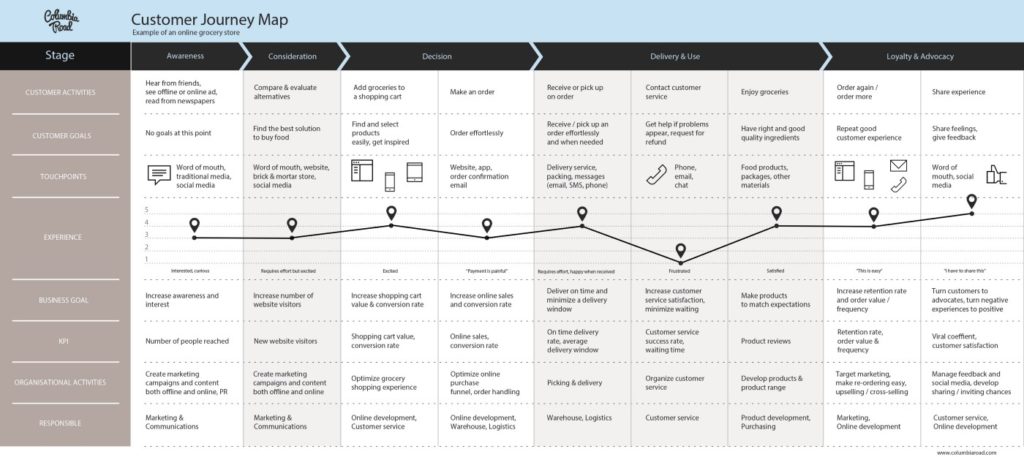
Example of a customer experience journey map
What is the difference between customer experience (CX) and customer journey?
Customer experience (CX) can be either pointing out the whole lifecycle of the user or in regards to just one touchpoint with a product/service. However, the customer journey is a presentment of the touchpoints a customer engage with a brand. Then, what are the five steps to map the customer journey?
Nielsen Norman Group: Customer journey mapping
- Timeline: Important turning points that map the changes in customer relations with the brand over time.
- Personas: Half-imaginary characters, typifying basic personal features of a wider customer group, based on data collected from user research, combined with web analytics.
- Emotion: Symbolic representation on the mood line of a customer’s emotional landscape at the moment of interaction.
- Channels: Entire vehicles of customer interaction and touchpoints with the brand.
- Touchpoints : Any and every moment of customer actions and interactions with the organisation or its products.
After defining the basics, it’s time to observe the customer experience flow and illustrate it as a roadmap. Megan Grocki, Experience Strategy Director at Mad*Pow, explains the nine key steps of designing a CX journey map in a video she prepared for UX Mastery.
How to create a customer journey map
In summary, here’s how we can repeat these nine steps, which visually form the crest of a wave.
So, how to create a customer journey map?
1. Review the goals
Consider the goals of the CX journey mapping process, as well as the goals of the organisation and its product or service.
2. Gather research
Conduct research based on relevant resources, including both qualitative and quantitative findings, and gather the results together.
3. Define channels and touchpoints
Work on determining channels and touchpoints where your customer will interact with your organisation, product or service.
4. Create an empathy map
To understand your customer’s emotional landscape, focus on what s/he is thinking, feeling, seeing, hearing, saying and doing.
5. Look at it from different perspectives
Practise generating ideas quickly by looking at problems and scenarios from different perspectives.
6. Create an affinity diagram
Organise your ideas visually, and classify and categorise them cohesively.
7. Sketch the customer journey
Draw a sketch of the CX journey map to make it comprehensible for your team.
8. Refine and digitalise
Create a digital map to help clarify any confusing details from the sketch.
9. Share and put in use
Now you are ready to take a journey through the eyes of your customer.
Lastly, it would help if you remember that customer journey maps need to be updated as conditions change since they are based on existing data and personal experiences. For this very reason, no CX journey map can be accurate forever and applied in different instances in different stages of a project. In other words, each CX journey map is as unique as each customer of an organization. Therefore, you should –not only today but always– keep your data and data processing up-to-date to know your customers better.
Customer journey maps examples
An example of a B2C customer journey map.
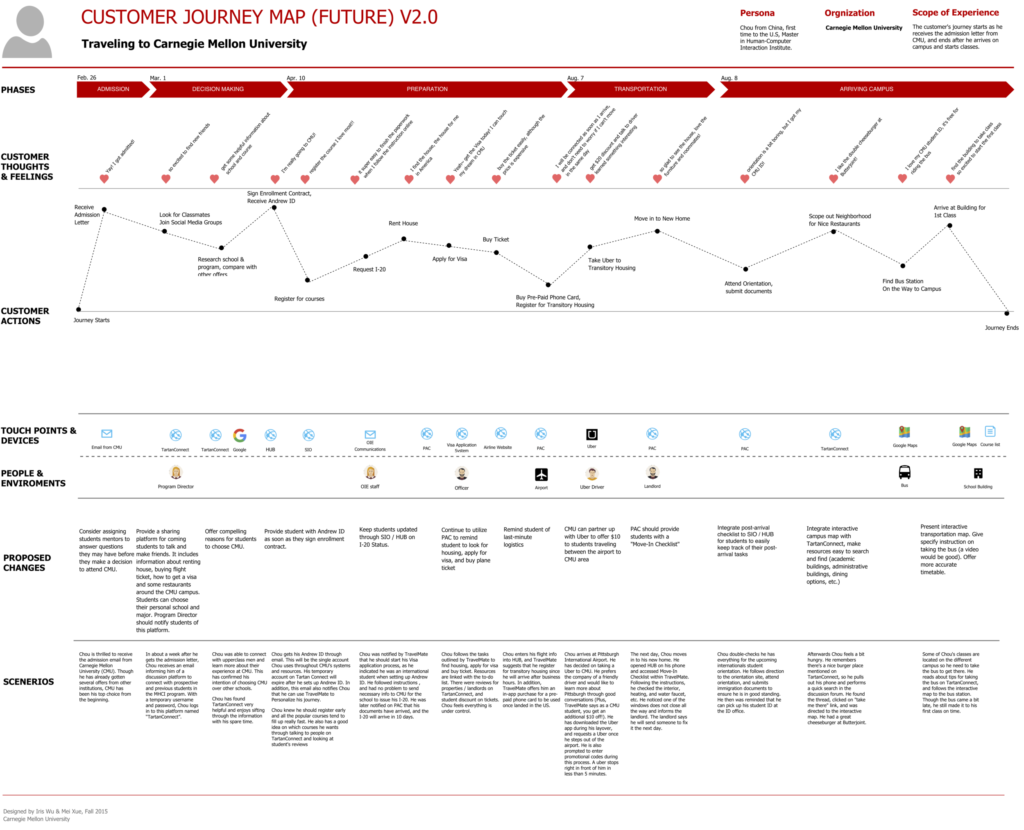
Customer journey map example (Source: Iris Tong Wu)
An example of a retail customer journey map.
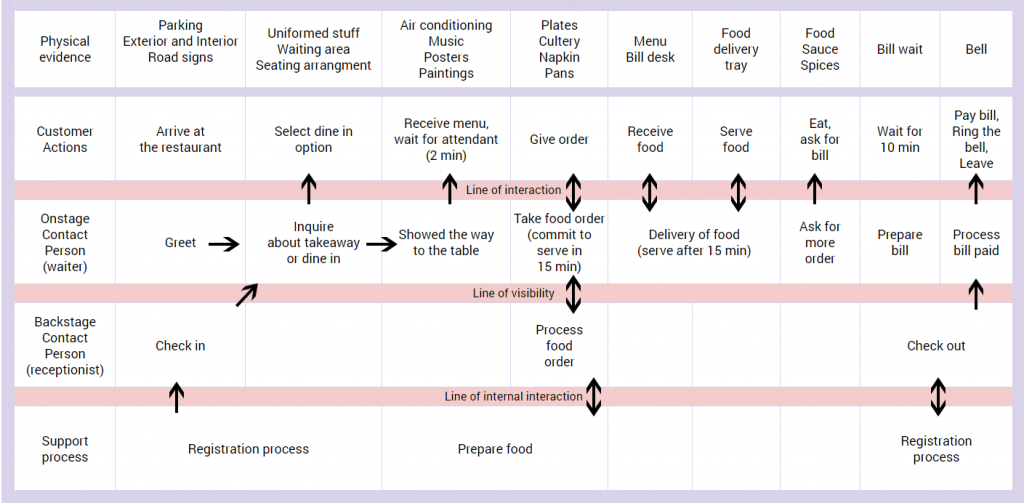
Customer journey map example (Source: UXPressia)

Thank you for Subscribe us
Thanks for your interest, we will get back to you shortly
Home » Digital Adoption » Process Map vs. Journey Map: Key Differences
Process Map vs. Journey Map: Key Differences

- Updated February 9, 2023

A process map and a journey map can each be useful, but they each have a different use case.
In this post, we’ll learn about the difference between these two business tools, what their advantages are, and how to make the most of each one.

Process maps and journey maps are clearly defined tools, so before implementing either, it is important to clearly understand those differences.
Process Maps
A process map is a visual representation of a business process.
That business process can be a simple workflow belonging to an individual employee, or it can be a complex business process being performed by multiple departments.
Processes can be mapped using several methods, including:
- Flowcharts , which use geometric shapes and lines to outline the business process
- Swim lanes, which break a business process down by the functions that contribute to it
- Value streams, which are diagrams that take a top-down perspective of business processes
There are several reasons why process maps have become standard in many organizations.
For instance, process maps:
- Allow viewers to quickly understand a business process. Process maps may be used or reviewed by a large number of people, particularly for complex processes in an enterprise setting. Therefore, it is important to create a diagram that can be understood simply by looking at it. Doing so allows viewers to quickly grasp the process, while also reducing ambiguity – a problem that can occur when using words alone to document processes.
- Can be used to analyze processes and improve upon them. Workflow and process efficiency can have a significant impact on employee productivity , organizational performance, business agility, and more. One of the key benefits of process maps is that they streamline process improvement and make it easy to optimize resources, tasks, time, money, and all other elements that are part of a process.
- Provide a common, unambiguous language that can be used to discuss processes. Since processes can be viewed by so many people, it is important to describe them in a way that anyone can understand. The use of notation systems, such as BPMN , ensures that everyone understands exactly what a process map is describing. If, on the other hand, each process map uses its own design language and terminology, process mapping can have the opposite of its intended effect – namely, it can make processes more difficult to understand, analyze, and standardize.
In short, process maps are useful from an engineering perspective. They allow managers, enterprise architects, business process managers, and other professionals to understand, analyze, and measure processes.
Journey Maps
Journey maps are used to diagram a person’s experience, such as the the experience of a customer, an employee, or an app user.
For instance, journey maps may outline:
- A customer’s pathway to purchase
- The product adoption process
- The employee life cycle
Depending on who creates them, process maps may differ in detail and scope.
Some may cover an entire user experience from beginning to end. Others, however, may only cover small segments of a journey.
Likewise, some maps may be extremely detailed, while others may be more general.
That being said, there are many elements common to many journey maps, such as:
- Clearly defined goals and objectives for each stage
- Stages for the journey laid out along a timeline
- Descriptions of the typical individual undertaking the journey
- Metrics and KPIs that can help measure the process’s performance
Journey maps can be used by a wide variety of professionals, from UI designers to marketers to product developers to employee experience managers.
Choosing Between Process Maps and Journey Maps
Asking these questions can make it easy to decide which tool to use:
- Am I designing a product, experience, or service ?
- Is my map going to be used by a team of specialists?
- Does my map describe the perspective of the end recipient of the process?
Answering yes to these questions would suggest that you need a journey map. After all, journey maps are typically used by specialists to create better experiences for the end user – hence the term “journey map.”
On the other hand, if you answer yes to any of these questions, you may need a process map:
- Is my goal to understand and/or optimize a business process?
- Will this map be used or viewed by those outside of a specialized team?
- Does the map make use of a common notation or language?
- Does the map focus on the events and activities within a workflow ?
Though there is some overlap between the two, choosing the right tool shouldn’t be too difficult.
The key difference between the two is this: process maps describe those performing the process, while journey maps are built around those experiencing the end result of a process.

A wonderful team of Digital Adoption, Digital Transformation & Change Management Experts.
RELATED ARTICLES

What is a cross-functional team + examples?

16 Employee engagement survey questions

Conversational AI vs Generative AI
Most popular.

24 Best AI productivity tools for 2024

18 Types of process improvement methodologies

Contact Us: [email protected]
This blog is powered by WalkMe. By subscribing to our newsletter, you agree to the Terms and Conditions . For more information about the processing of your personal data please check our Privacy Policy .
POPULAR POSTS

POPULAR CATEGORY

Skip navigation

World Leaders in Research-Based User Experience
Journey-mapping impact: research findings.

December 19, 2021 2021-12-19
- Email article
- Share on LinkedIn
- Share on Twitter
Journey maps visualize a user’s journey towards a goal, usually over time and across channels . Journey maps are a powerful tool for evaluating an experience and establishing a shared understanding among team members.
To learn how journey maps are used in industry, we surveyed more than 300 user experience professionals . In this article we share our findings on how practitioners create journey maps and their perceived success of these initiatives.
In This Article:
Approaches to journey mapping, impact and success ratings.
We asked participants to select which of the following options described how they created their last journey map:
- An individual created the initial map using a digital tool (e.g., Mural, Miro, Google Sheets, Adobe Illustrator)
- An individual created the initial map in a physical setting with tangible tools (e.g., wall-mounted paper, sticky notes, stickers)
- A collaborative team created the initial map in a physical setting with tangible tools (e.g., wall-mounted paper, sticky notes, stickers)
- A collaborative team created the initial map using a digital tool (e.g., Mural, Miro, Google Sheets)
Our findings indicate most journey maps are created collaboratively with a team of individuals . Out of 259 responses, 64% (95% confidence interval: 58% to 70%) said they created their last journey map collaboratively with a team. In contrast, 36% (95% confidence interval: 30% to 42%) created the map independently. Whether the respondent worked in house at a company or at an agency seemed to have no effect on this finding. In either context, cocreating a journey map with a team is more popular than creating it individually.

Percentage of respondents who reported creating their last journey map independently vs. in collaboration with a team (Error bars represent 95% confidence intervals.)
We also found that the majority of our respondents created their last journey map with digital tools rather than tangible tools . Out of 259 responses, 56% (95% confidence interval: 50% to 62%) used digital tools like Miro or Google Sheets to create their map, whereas 44% (95% confidence interval 38% to 50%) used tangible tools like sticky notes to create their maps in a physical environment.
(Note that, because this data was collected in November of 2020 during the pandemic, it is possible that more people than normal used digital tools rather than tangible ones.)
Again, whether participants worked in an agency or in house seemed to have no effect on the data.

Percentage of participants who used digital vs. tangible tools (Error bars represent 95% confidence intervals.)
In the next section, we discuss respondents’ perceived success of their journey mapping initiatives and how these approaches (independent vs. collaborative; digital vs. tangible tools) impacted their responses.
What is the organizational impact of creating journey maps? We asked practitioners to rate how successful their last journey-mapping initiative was in 7 areas. The scale was from 1=not successful at all to 5=extremely successful.

Respondent’s average success ratings for seven outcomes of customer-journey maps (The grey vertical line at 3.5 indicates our success barrier; error bars represent 95% confidence intervals.)
Across the board, practitioners rated their last journey-mapping initiative as moderately successful in 6 out 7 areas. We deemed ratings with an average of 3.5/5 or higher (70% or more) as successful. There were two areas that had significantly higher success scores than the rest: educating internal parties about painpoints or unmet needs and creating alignment among teams. One factor had a significantly lower success rating: persuading management to make internal optimizations. These findings are consistent with our knowledge about the benefits of journey mapping.
In our experience, there are many techniques to achieve these factors of success — journey maps aren’t the only way. For example, persuading management to invest efforts in creating new features can be done through communicating user sentiment as indicated by data from a survey or usability testing. This persuasion can be aided by creating journey maps that identify needs which could be targeted by future features, but that is an added benefit not necessarily the primary reason for creating the map.
Differences Between Collaborative and Independent Journey Mapping
How do respondents’ success rating differ when the map was created with a collaborative team or an individual? In most cases, we observed similar success ratings between those that created their journey maps in collaborative teams compared to those that created them independently . However, for one factor, creating alignment among internal teams, we observed a marginally significant difference (p value = .1): those who created their maps collaboratively with a team reported higher success rates for creating internal alignment . This is logical because, when a team cocreates the map (rather than being presented with it later), it is more likely to trust the insights.

Respondent’s average success ratings for seven outcomes of customer-journey maps, segmented based on whether the map was created collaboratively or independently (Error bars represent 95% confidence intervals.)
Differences Between Journey Mapping with Digital and Tangible Tools
What impact does tool selection (tangible vs digital) impact respondent’s success ratings? We did not observe a significant difference between the success ratings in those that created their journey maps with a digital tool versus tangible tools. In other words, it doesn’t matter whether you start with a digital tool or later convert your physical map into a digital copy.

Respondent’s average success ratings for seven outcomes of customer-journey maps, segmented based on whether the initial map was created with tangible or digital tools (Error bars represent 95% confidence intervals.)
Improve the Success of Your Journey Mapping Initiative
There are many factors that will affect the success of your journey mapping initiative. For example, identifying the right scope and goals , recruiting representative participants , and identifying and prioritizing pain points will all play a role in the success of your initiative. As our research shows, neither creating your map independently nor collaboratively, or with digital or tangible tools, will guarantee you absolute success.
We asked participants (n=234) to rank 8 factors in how critical they are to successful journey mapping initiatives . The following table documents respondent’s average rank scores (high rank scores signify high importance; rank scores range from 1 to 8):
Interestingly, the top 4 factors that received highest rank scores make up the first step in the process we recommend for creating these artifacts . Note also that the visual design of the artifact had the lowest rank score –- though it does matter to communicating your journey, many other factors are more important.
When it comes to journey mapping in your organization, prioritize involving customers and a crossfunctional team, as well as defining the right scope (persona and journey). In a related article, we share 27 tips from practitioners on how to get started with journey mapping. The first map won’t be perfect, but use this information to help you prioritize your efforts. Equally important, after your work is complete, reflect on your practice and document what you would do differently next time. Use this insight to evolve your craft over time.
Whether you craft these artifacts individually or in a team, digitally or tangibly, journey maps can have a positive impact on your organization. Our research shows that journey-mapping initiatives tend to be successful at creating internal alignment and educating the team about user pain points. As practitioners, understanding the potential impact of these initiatives can help you sell and set expectations for the work.
Related Courses
Journey mapping to understand customer needs.
Capture and communicate UX insights across complex interactions
Becoming a UX Coach
Empowering UX and product teams to reach their full potential
Managing User Experience Strategy
Understand, plan, and implement UX strategy
Related Topics
- Customer Journeys Customer Journeys
Learn More:

Journey Management vs. Service Design
Kim Salazar · 4 min

Types of User Pain Points
Sarah Gibbons · 4 min
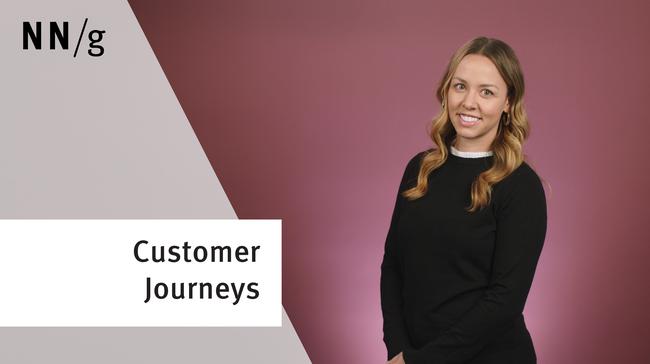
What Is Journey Management?
Kim Salazar · 3 min
Related Articles:
Journey Mapping in Real Life: A Survey of UX Practitioners
Kate Kaplan · 7 min
How to Conduct Research for Customer Journey-Mapping
Remote Customer Journey Mapping
Kate Kaplan · 5 min
The Practice of Customer-Journey Management
Kim Salazar · 7 min
How to Run a Journey-Mapping Workshop: A Step-by-Step Case Study
Kate Kaplan · 10 min
Journey-Mapping Approaches: 2 Critical Decisions To Make Before You Begin
Kate Kaplan · 8 min
Sign up today for O*Academy’s Design Research Mastery Course
- UX Research & UX Design
- UX Staff Augmentation
- Service Design
- Design Workshops
- Case Studies
- Why Outwitly?
- Outwitly Team
- Diversity, Equality and Inclusion
Customer Journey Maps vs. Service Blueprints: What’s the difference?
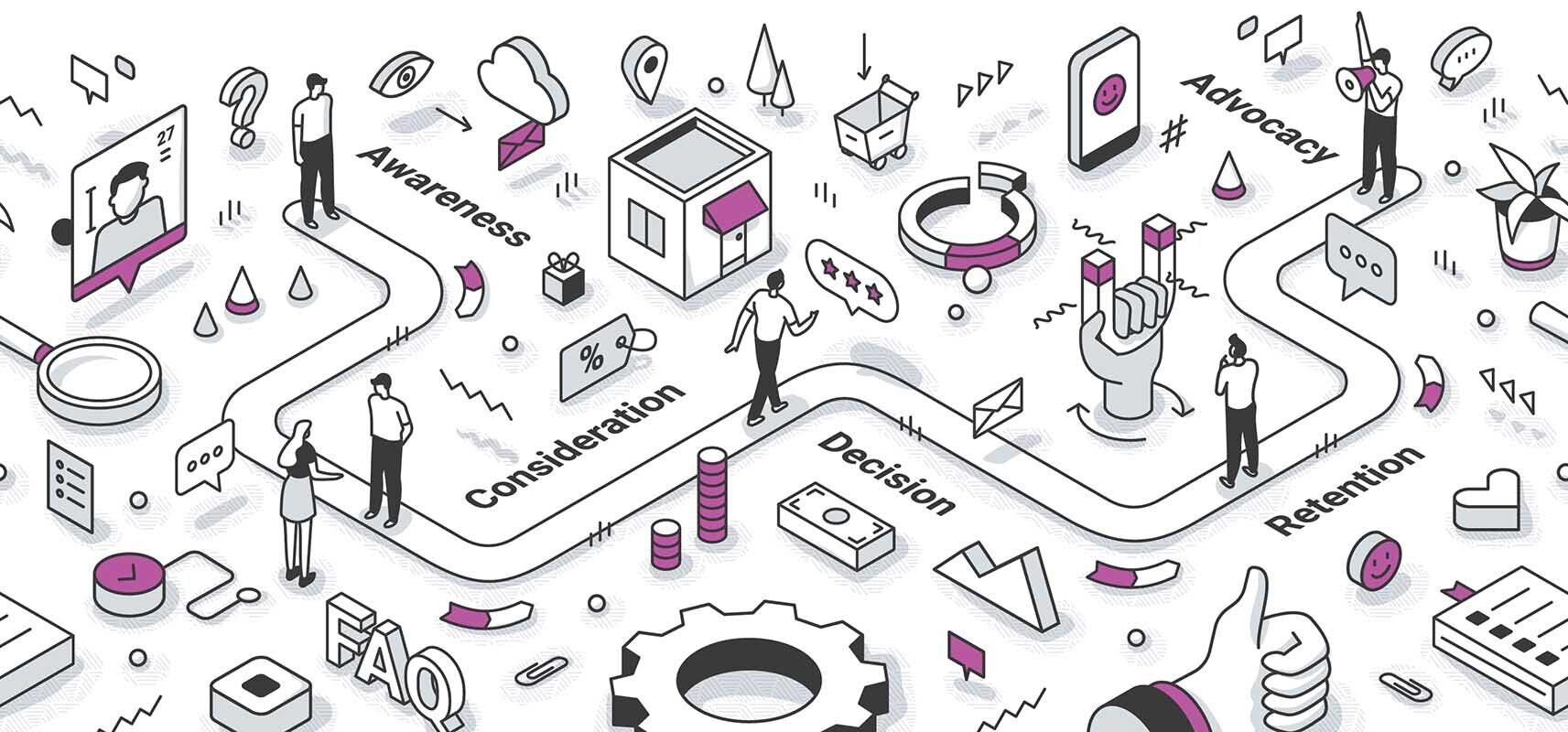
When it comes to design research tools, two of the most frequently used are Customer Journey Maps and Service Blueprints . Both are incredibly valuable communication tools that show the end-to-end processes and experiences of your staff and customers. BUT, what’s the difference, and how do you know which one is right for your project?
Whenever we meet with a new client or read a project brief, we’re faced with some of the same questions. Today we’re answering those tricky questions and breaking it down for you:
What is a Customer Journey Map?
What is a Service Blueprint?
What is the purpose of each tool and why are they helpful?
What are the key differences between each tool?
How to choose the right tool for your next project?
Core Concepts of Service Design
Before we can really dive into the differences between the mapping tools used in service design, we need to explain the core concepts of service design — and we’ll use the analogy of a theatre or play.
One of the biggest differences between journey maps and service blueprints is the actors or people that are considered in each one. In service design, actors are anyone involved in customer interactions and supporting business activities and processes that directly impact the customer’s experience. For example, store clerks, customer service/support, warehouse staff, and customers themselves.
Service design also uses a theatre analogy to explain the different parts of the service, all that goes into making it work, and which parts of the service are customer facing versus operational.
Front-Stage : The front-stage includes everything the customer sees and experiences. These are activities conducted by the people involved directly with your customers. Using the analogy of a theatre, they could be the play actors, ticket sales people, snack kiosk workers, ushers… and more!
Back-Stage : Back-stage activities are behind the line of visibility and involve the people and activities that your customer’s don’t see. Back to the analogy of a play, back-stage activities can include lighting, sound, rehearsal, costumes, and a lot of people reading lines getting ready to take their turn on the front-stage. Without these activities, the show would not go on and it certainly wouldn’t be a great experience for the audience. Applying the back-stage theatre analogy to business, these jobs are often customer support representatives, warehouse workers, managers, etc.
Behind-the-Scenes: These are all of the activities that customers don’t see, but they ensure that the production goes off without a hitch. It’s all of the support processes, administrative work, standard operating procedures (SOPs), and organizational tasks that need to happen to ensure the organization is running smoothly.

Customer Journey Maps
What is a customer journey map.
A customer journey map is a visual representation of the end-to-end experience your customers have when they interact with your service or try to accomplish a goal through something you offer (e.g. trying to renew their driver’s license). We always recommend that journey maps are created using in-depth research (such as interviews and observations ) with your company’s real customers and users. The “actor” in customer journey mapping is the customer or end-user themselves. It’s an artifact that is created from the perspective of your customer or end-user. Typically, a journey map will also consider the front-stage experience, but won’t dive deep into the activities of other actors (or staff).
A journey map will include all of the tasks and activities of a user or customer, their pain points and challenges, and the brand touchpoints they encounter (e.g. your website, an app, a customer support person, and more). It also includes the thoughts and feelings they experience as they go along their journey. These among other attributes of the map help to tell a story of what that person’s experience was, and all of the steps and miss-steps they took along the way.
Why is it useful?
Customer journey maps are useful for highlighting key areas in the customer’s journey that provide a poor experience and highlighting opportunities for improvement within your product or service. Customer journey maps can also show major inefficiencies in the customer experience. Take for example someone who is trying to use an online system to remedy a billing issue and update their payment information — If for some reason the online service doesn’t work or provide the information they need, your customer resorts to calling the support team. Here, they wait on hold before having to explain themselves to a few different people and their goal of fixing their credit card information be accomplished. As you can imagine, and have probably experienced in your own lifetime, this is a bad experience. By outlining this arduous journey, we discover key areas of improvement and places where processes could be streamlined.
The ultimate goal of customer journey mapping is to:
Identify areas for improvement and places to reduce friction – ultimately making things easier for the customer.
Identify new product, service, or feature opportunities!
Prioritize which areas of the experience should be fixed first – (journey maps are great at showing the relative importance of one issue over another, since they are all in one map together)
Bridge the gap between siloed teams. Not every department is focused on customer experience, but surely the customer’s experience throughout different parts of the journey will impact your organization’s various departments (such as marketing, IT, and customer service).
Build empathy for your customers by stepping into their shoes. You’ll find out what their experience is really like, what’s motivating them, and most importantly, what’s bugging them! So you can fix it and design a better experience.
Service Blueprints
Okay, so now you know what a customer journey map is and why they are helpful tools. Let’s dive into service blueprints.
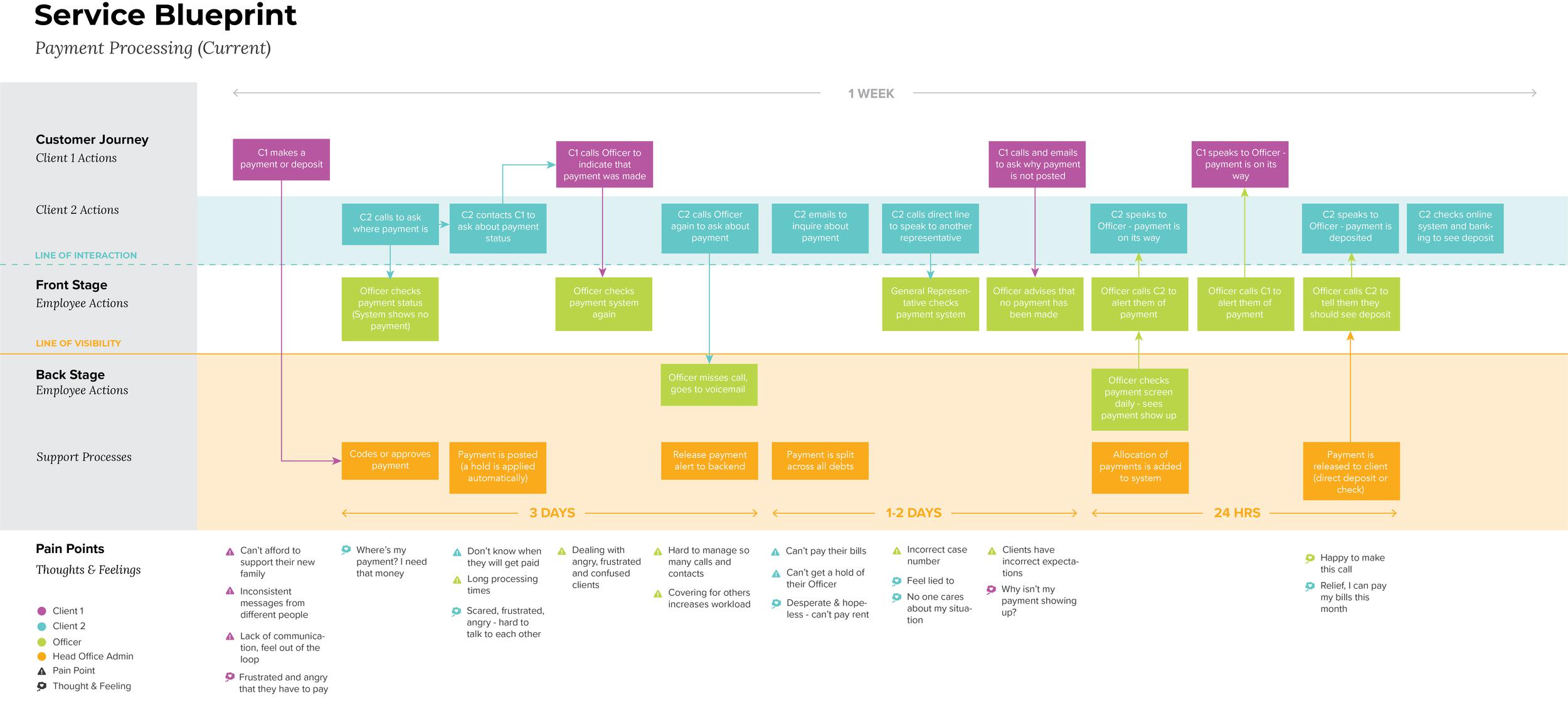
What is a service blueprint?
Service Blueprints focus on how an organization supports the customer journey, keeping customers, staff, and other key players at the forefront. Blueprints depict the business’s processes and operations that occur within the front-stage (customer facing), backstage (internal) and behind-the-scenes! Ultimately, a service blueprint is a business process mapping tool. The main differentiator between service blueprints and other mapping tools? Instead of “swimming lanes” used in traditional workflow diagrams to depict different task owners, we approach service blueprints from a human-centered lens . Similar to customer journey maps, service blueprints should be created through research with the actors (in this case, staff) involved. This might mean shadowing employees as they interact with customers and go about their day-to-day work, or conducting several interviews over a few days or weeks with employees. By doing this, we can understand what the back-end processes are and where your employees think things are going wrong/could be improved.
Service blueprints also tend to be a bit more specific – zooming in on a single business process vs. looking at an end-to-end journey with an entire service.
Service blueprints usually focus on actions and physical evidence (aka tools and technology needed by the actors to do their work). To summarize, the anatomy of a service blueprint includes:
Physical Evidence (tools, technology, websites, resources, etc.)
Customer Journey (actions/steps taken by customers)
Front-Stage (actions taken by employees who directly interact with customers, as well as the technology they’re using)
Back-Stage (actions taken by employees who help front-stage staff behind the line of visibility, or front-stage staff who complete an activity outside of the view of customers)
Behind-the-Scenes (actions taken by employees who support the business internally)
Pain Points (issues or challenges that staff might experience when completing certain tasks)
Time (the length of time it takes to complete certain tasks or a series of tasks)
Why are service blueprints useful?
Service blueprints are an amazing tool to outline the inner workings of your business. They look at all of the activities (good, bad, and useless) that your employees are doing and highlight the reasons why parts of the customer experience are failing. In particular, service blueprints help to:
Pinpoint weaknesses in the current business processes.
Find opportunities to optimize business and support processes – with a detailed breakdown of all the steps involved.
Tie the customer journey together with the inner workings of the company.
Understand complications and inefficiencies within your organization
View this post on Instagram A post shared by Outwitly | UX & Service Design (@outwitly)
Journey Maps vs. Service Blueprints over on Outwitly’s Instagram account!
Key Differences Between Journey Maps and Service Blueprints
Now that we understand both of these mapping tools, let’s call out their key differences:
Customer Journey Map:
Depict an end-to-end experience as a narrative
Focus on customer/users
Focus on the customer’s experience, thoughts and feelings, and pain points when trying to accomplish their goal
Focus on the customer actions and some front-stage (customer facing) tasks, tools, and touchpoints
Service Blueprint:
Depict the business processes and operations
Focus on customers and mostly on staff (and any other actors involved)
Focus on how the organization supports the customer journey (what activities, tasks, and physical evidence are needed)
Focus less on the actual visceral experience – but will usually show pain points
Focus on the front-stage, backstage, and behind-the-scenes tasks (using the customer journey as a foundation)
How to Choose the Right Tool?
Ultimately, these tools are complementary to one another. The customer journey map provides the step-by-step tasks that form the foundation for a service blueprint. To be specific, the activities completed by customers are the first row of tasks in a service blueprint. Journey maps can help you understand where to focus and which business areas may need further investigation using a service blueprint and service blueprints will breakdown all of the processes involved in making that experience a reality.
When to choose a Customer Journey Map
Start with a journey map when:
You want a broader understanding of your end-to-end customer experience
You need to learn about how your customer is experiencing your offerings (services, products, user interfaces, customer support, online touch points)
You don’t have a lot of clarity about where things are going wrong or why your customers are unhappy
Then once, you have a deeper understanding of the areas which need improvement — launch a service blueprinting activity to find out what is happening behind-the-scenes in the company.
When to choose a Service Blueprint
Create a service blueprint when:
You feel confident in your understanding of the customer’s all-encompassing experience, but need to alleviate friction with a specific pain point
You want to take a more detailed look into a specific process and find efficiencies!
Getting Started
If you want to know more about how to create a journey map, dive into our three-part blog series all about customer journey mapping!
The Power of Customer Journey Mapping: 101
How to Research and Build a Customer Journey Map: 201
How to Make your Journey Map Actionable and Creating Change: 301
Resources we like…
The Difference Between a Journey Map and a Service Blueprint by Practical Service Design
Defining Service Blueprints by Nielson Norman Group
Similar blog posts you might like...

Making your Journey Map Actionable and Creating Change: 301

Service Design, UX, & HCD: What’s the difference?
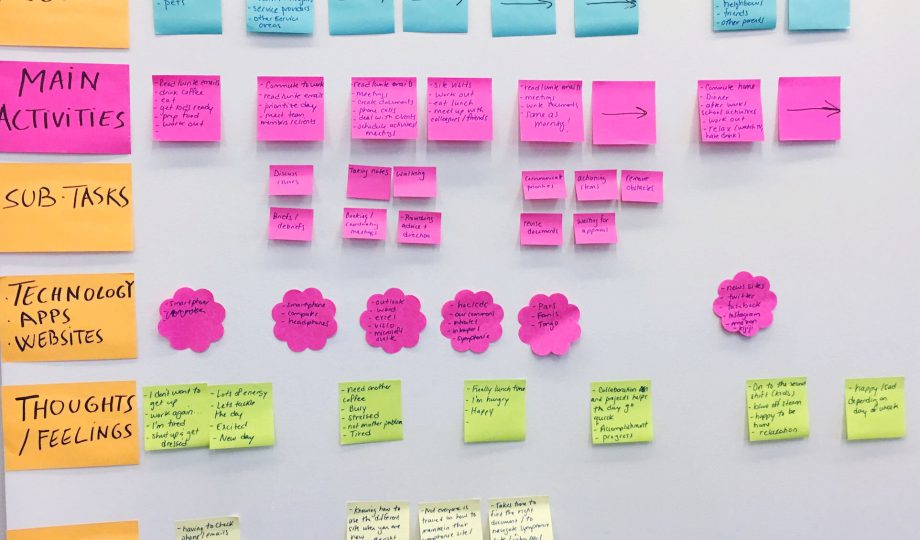
7 Steps to Better Customer Experience (CX)
Subscribe to the weekly wit, what you’ll get.
- Hot remote industry jobs
- Blogs, podcasts, and worthwhile resources
- Free ebooks, webinars, and mini-courses
- Tips from the brightest minds in design
Ready to conduct user interviews like a pro?
Download our free user interview workbook.

IMAGES
VIDEO
COMMENTS
Specific Customer Experience vs. Overall Customer Experience. An experience map depicts the experience of all consumers while interacting with a product or brand. On the other hand, a customer journey map is centered on the experience of a certain buyer persona. This gives them different dimensions in the perspective of consumer-related approaches.
Journey Map vs. Experience Map. Think of an experience map as a parent to a journey map. A journey map has a specific actor (a singular customer or user of a product) and specific scenario (of a product or service), while an experience map is broader on both accounts — a generic human undergoing a general human experience.
Settling the Customer Journey vs Customer Experience Map Debate. Looking at these two methods from a 'customer journey vs customer experience map' lens isn't fair as both of these mapping methods are used to track customer interactions with your brand. That said, while Customer Journey Maps are only tracking the touchpoint related to the ...
The difference between a customer journey map and an experience map is context. Experience Mapping is generalized, while Journey Mapping is specific to a customer, user or persona. And these techniques are not mutually exclusive. As part of a successful design thinking methodology, both of these mapping methods should be will be indispensable ...
A customer experience map, in contrast to journey mapping is more effective if you don't know where the problem is. You know something, somewhere, is falling short, and by approaching the exercise in an honest and open-minded manner, you can hopefully nail down exactly where the customer pain point's are when before, you might not have ...
It helps enhance our vision and strategy. 3. Unify Vision and Strategy. A customer experience map provides a holistic view of the customer journey. This can guide cross-departmental strategies. It allows teams across the organization to understand their impact on the customer experience and align their goals. 4.
A customer journey map, or CJM, while similar to an experience map, is more detailed and focuses on the customer's journey with a specific product or service, from discovery through to final purchase. The journey map is a visual representation that includes the details of each stage. This may include product awareness, research and inquiry ...
User Experience Mapping, also known as Customer Journey Mapping (CJM) is a powerful technique for understanding what motivates your customers - what their needs are, their hesitations, and concerns. Although most organizations are reasonably good at gathering data about their customers, data alone fails to communicate the frustrations and ...
The customer journey map (CJM) is one of the main tools that allows us to understand and improve customer experience. This video from Peer Insight shows a sample Customer Journey Map in action; but in essence, it is a graph which illustrates the steps customers go through: from initial contact, through the process of engagement, and hopefully into long-term loyalty.
2. A customer journey map covers the path from discovery of a need/desire through to finding brands and products appropriate, to purchase. It's the journey up to becoming a customer. A customer experience map includes the above, but also continues through ownership, usage, service, support, recommendations, reviews, references, responses and ...
User experience journey mapping is an ongoing process. Constantly update it as new data emerges from user feedback and analytics. Userpilot is a product growth platform that you can use to research user personas, analyze user interactions with the product, and improve user experience with UI patterns. Book the demo to discover how!
An experience map is a visualization of a complete end-to-end experience mapping experience that a "generic" person goes through to achieve a goal. ... Experience Map vs. Customer Journey Map: Is there a difference? Yes, there is! But the truth is, they can be easily mixed up. The confusion is given because both maps are usually divided ...
A long time ago (circa 2014) I developed a reasonably complex UCD methodology for multi-channel customer journey mapping — the kind of thing that requires qualified UX or Service Design ...
Experience mapping and journey mapping can seem confusingly similar, and there are certainly elements in both that overlap. But there are a few very key differences to be noted when deciding if a journey OR experience map will best serve the needs of your organisation. Simply put, a customer experience map is a total visualisation of the big ...
This article is a compilation of our articles and videos on topics related to UX mapping methods. Resources cover specific types of UX maps — such as journey maps, service blueprints, and roadmaps — as well as lesser-effort mapping techniques for common UX-related work, such as exploring design ideas and communicating research insights.
An experience map is a visualization of the end-to-end user experience that an average user goes through to accomplish a goal. Unlike journey maps that focus on illustrating the experience users have with a particular product, this method helps create a general understanding of human behavior in a larger context without focusing on a specific product. . It allows for understanding users ...
Depending on the context of your project, some relevant methods for journey-mapping research include: Customer interviews. Direct observation. Contextual inquiry. Diary studies. If your budget or timeline is limited, a small sample size (6-8 research participants) is enough to get started.
Step #2. Explain the anatomy of an Experience Map. There isn't a "best way" to do this, but a typical Experience Map can look like this one we prepared for Mortgage Success. Each step in the journey is a column, with each row representing the key information you need to collect.
7. Sketch the customer journey. Draw a sketch of the CX journey map to make it comprehensible for your team. 8. Refine and digitalise. Create a digital map to help clarify any confusing details from the sketch. 9. Share and put in use. Now you are ready to take a journey through the eyes of your customer.
The key difference between the two is this: process maps describe those performing the process, while journey maps are built around those experiencing the end result of a process. 5/5 - (2 votes) In this post, we'll learn about the difference between a process map and a journey map, what their advantages are, and how to make the most of each one.
Journey maps visualize a user's journey towards a goal, usually over time and across channels.Journey maps are a powerful tool for evaluating an experience and establishing a shared understanding among team members. To learn how journey maps are used in industry, we surveyed more than 300 user experience professionals.In this article we share our findings on how practitioners create journey ...
Customer Journey Design Methods Service Design. outwitly. Ottawa, Ontario. View profile. outwitly. 885 posts · 2K followers. View more on Instagram. 43 likes. In this blog, we break down the definitions, similarities, and differences between customer journey mapping and service blueprinting.